1lumen selects and reviews products personally. We may earn affiliate commissions through our links, which help support our testing.
Speras M10 Plus review
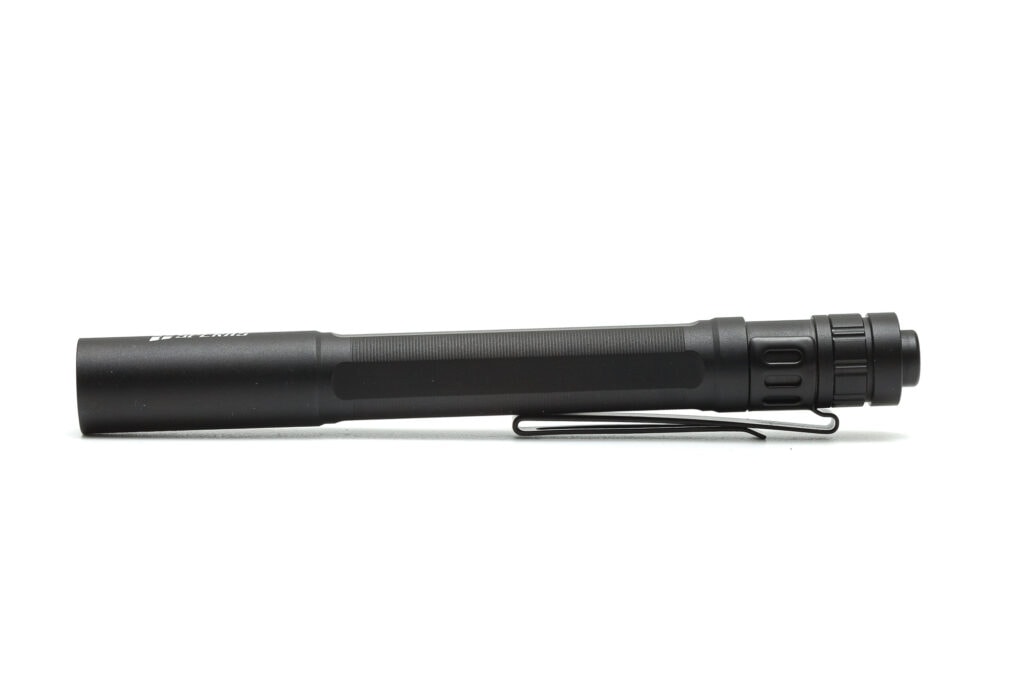
Speras M10 Plus specifications
| Brand/Model | Speras M10 |
|---|---|
| Flashlight category | Best penlight flashlights |
| LED | 1*SST20 4000K CRI90 / 6500K |
| Max. output | 200 lm (4000K) / 250 Lumens (6500K) |
| Max. beam distance | 60m / 70 meters |
| Max. beam intensity | 906 cd / 1225 cd |
| Battery config. | 2*AAA |
| Onboard charging | N/A |
| Modes | 3 |
| Blinkies | N/A |
| Waterproof | IP68 |
| Review date | March 2023 |
Review intro:
Speras has a wide variety of flashlights, ranging from small keychain flashlights to the P10R v2 thrower pumping out 10,000 lumens.
Meet the Speras M10 Plus, a new Penlight flashlight from Speras, available in a cold white, and neutral white High CRI LED. We’ve received both versions for testing.
Package quality.
The flashlights arrived in simple retail packaging that is designed to be hung on a retail display hook. The package features a clear picture of the flashlight on the front. This will give you a good idea how what the flashlight looks like. On the side of the package are 2 checkboxes to indicate each LED version. The top checkbox is for 6500K and the bottom one is for 4000K / CRI 95.
On the back, you can find the flashlight’s features and specifications. This is what you find inside the box:
- The flashlight: Speras M10 Plus
- 2*AAA batteries (without an insulator)
- 2 spare O-rings
- Manual
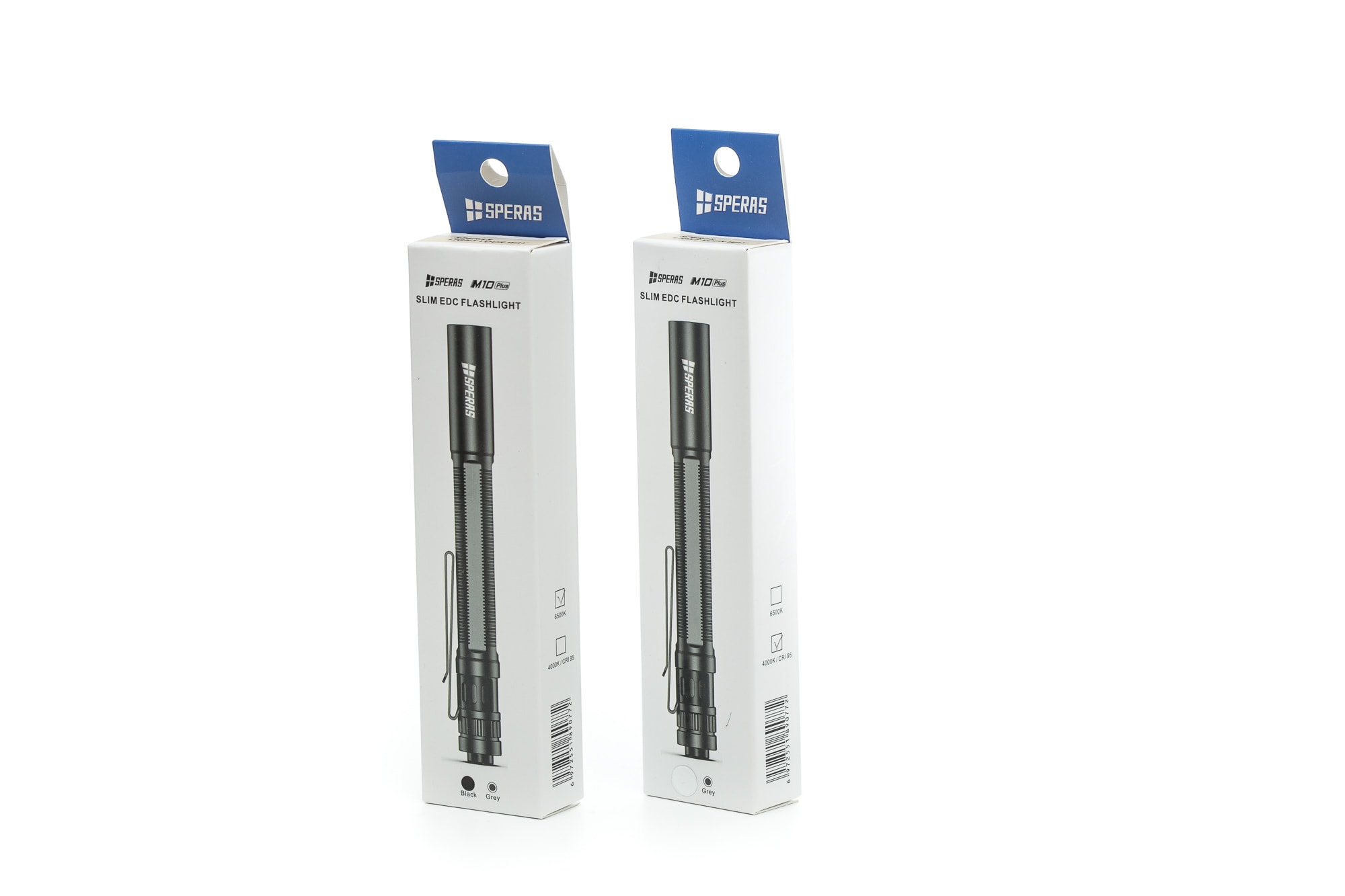
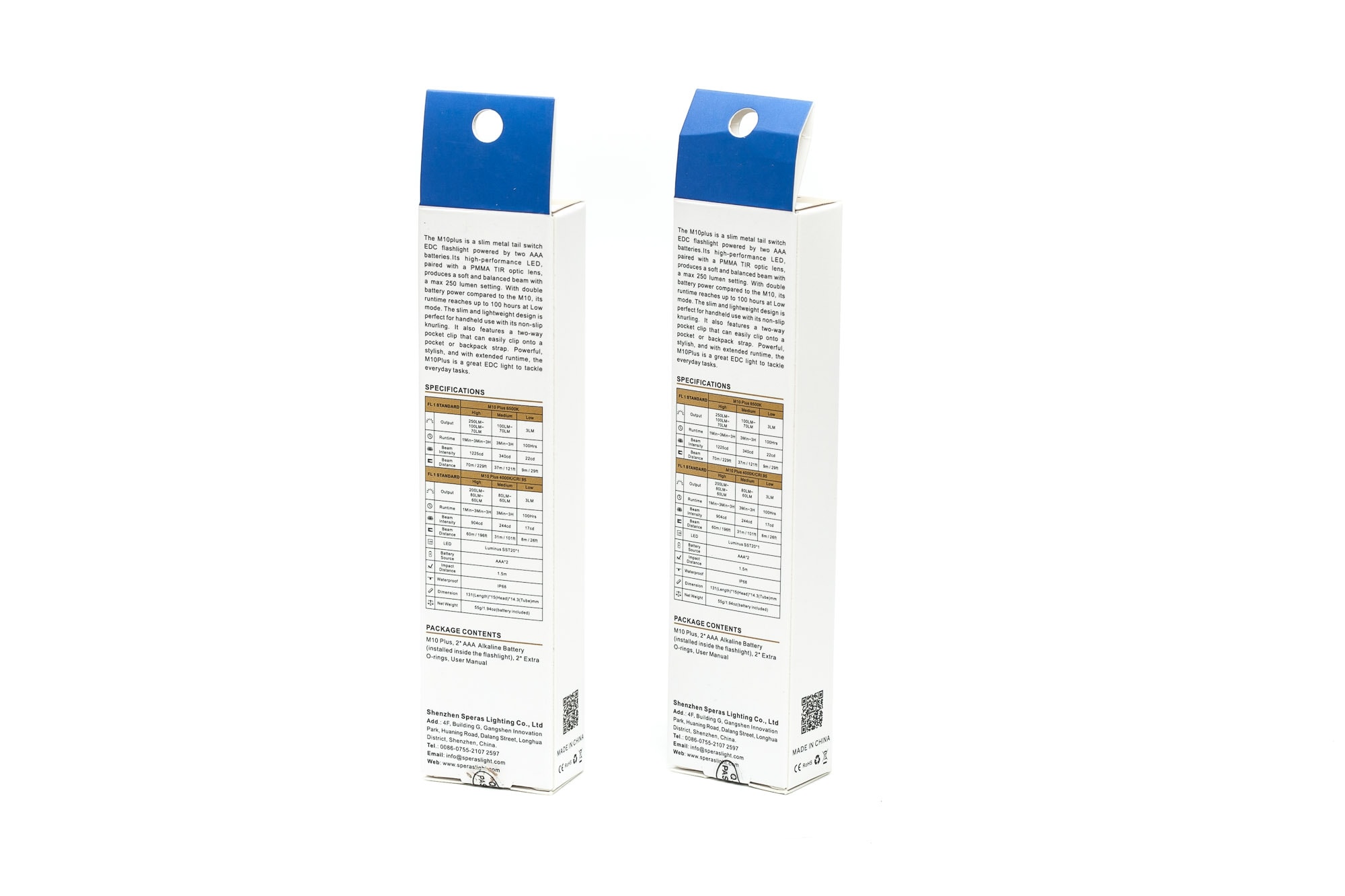

Flashlight in use
The M10 Plus is shipped with 2 AAA Alkaline batteries but without an insulator. This can be great if you want to start using the flashlight out of the box. But there’s also a problem with mine. 1 of the 2 flashlights I received arrived with dead batteries. They measured far below 1V. That means that somehow the flashlight was turned on… just somehow.
The body has some knurling but is not very rough, and slippery. The pocket clip gives you a bit more grip, and because of its length, feels a bit more secure in hand than the much smaller M10.
The pocket clip is pretty neat. It is a 2-way pocket clip, so you can carry it relatively deeply in your pocket, but also clip it to the bill of a baseball cap. That way, it works like a headlamp, so you have both hands free for the task at hand. I must admit that this is easier with the M10 than the M10 Plus, but it still works.
The switch is a reverse-clicky, so you can change modes when the flashlight is activated. This is the opposite of a forward clicky switch (which its sibling M10 uses) which can only change modes when the flashlight is deactivated.
That adds to the variety of tasks you can use the M10 for. It’s probably okay to use as a mechanic, or as a nurse. Just keep in mind that you don’t accidentally blind someone when pointing the light into somebody’s eyes. The 4000K, high CRI version could be used by nurses to check people’s eyes.
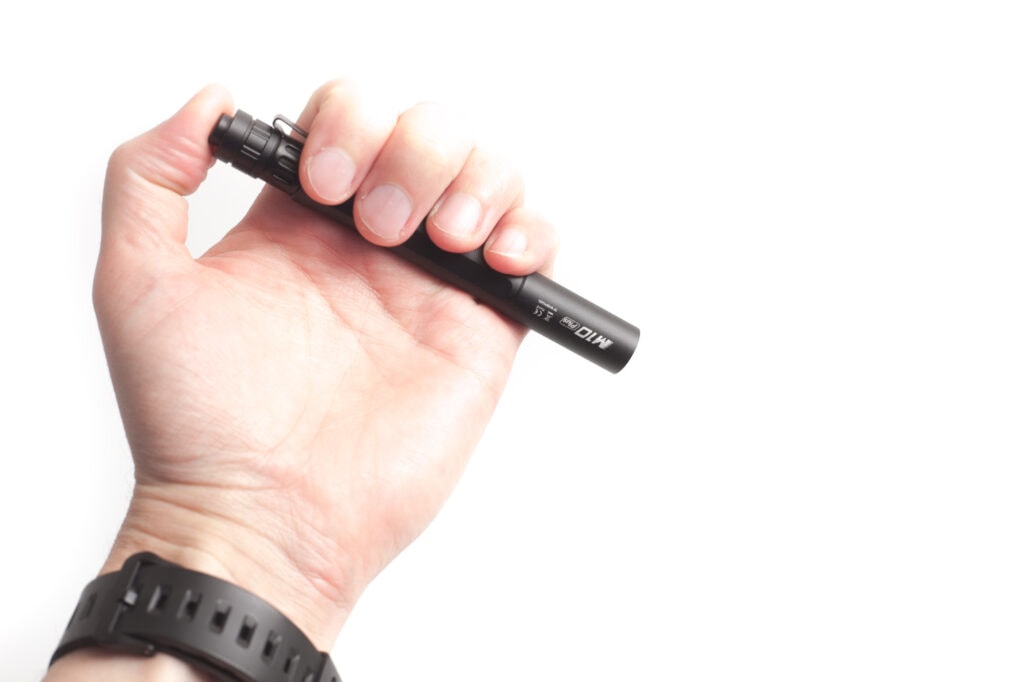
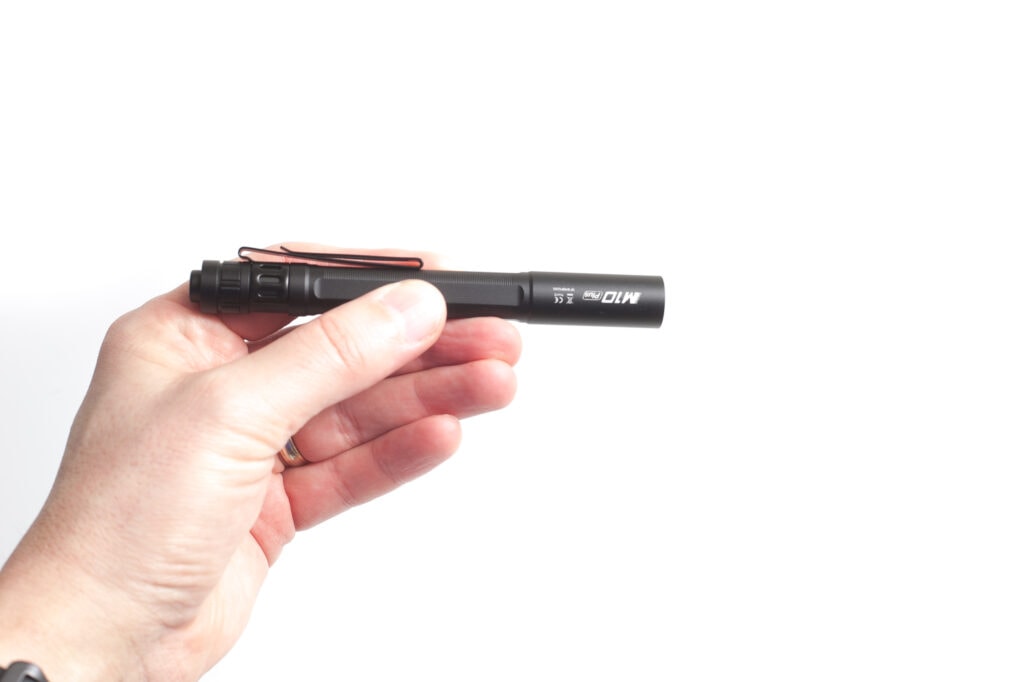
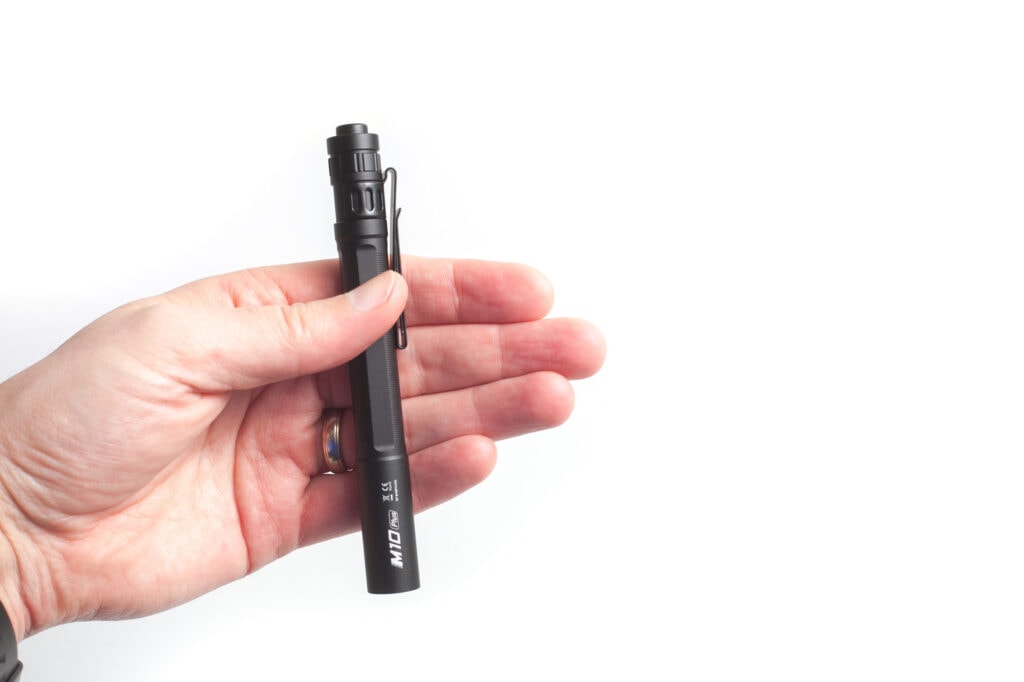
Build Quality and Warranty
While the build quality of the M10 Plus may not be the best in class, it’s still pretty good.
The machining appears to be of pretty good quality and the tailcap is the only removable part.
The tailcap has brass threading, so it screws nicely and smoothly.
The M10 Plus is available in 2 different colors (black and gray), and the coating is referred to as Premium Type III Hard Anodization.
The Warranty according to the Speras website:
1. Within 30 days, free replacement. SPERAS will provide 30 days free replacement service of purchase for any manufacturing defects if problems come into being in normal use; We will replace it with the same model. If the model has been discontinued, customers will receive a product with similar or improved model.
2. Within Warranty time: Usually we provide 5 years warranty, some may provide lifetime limited warranty( for example E1). Within the warranty time, any defects please contact local dealer or distributor for warranty support. We will repair or we replace a new product for you according the defects.
3. The free warranty does not cover any damages or failure caused by:
a. Normal wear
b. Rough operation
c. Battery leakage
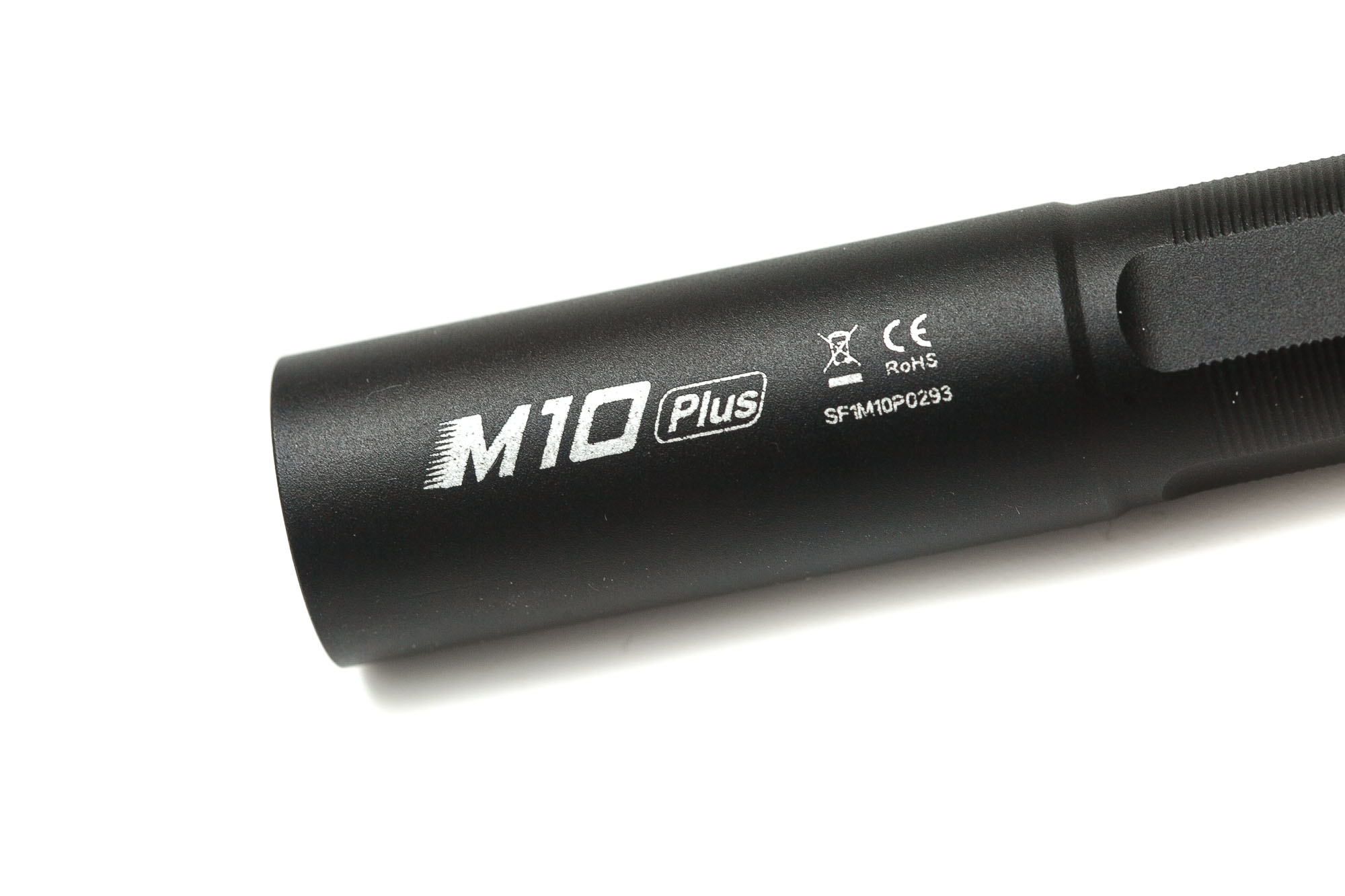
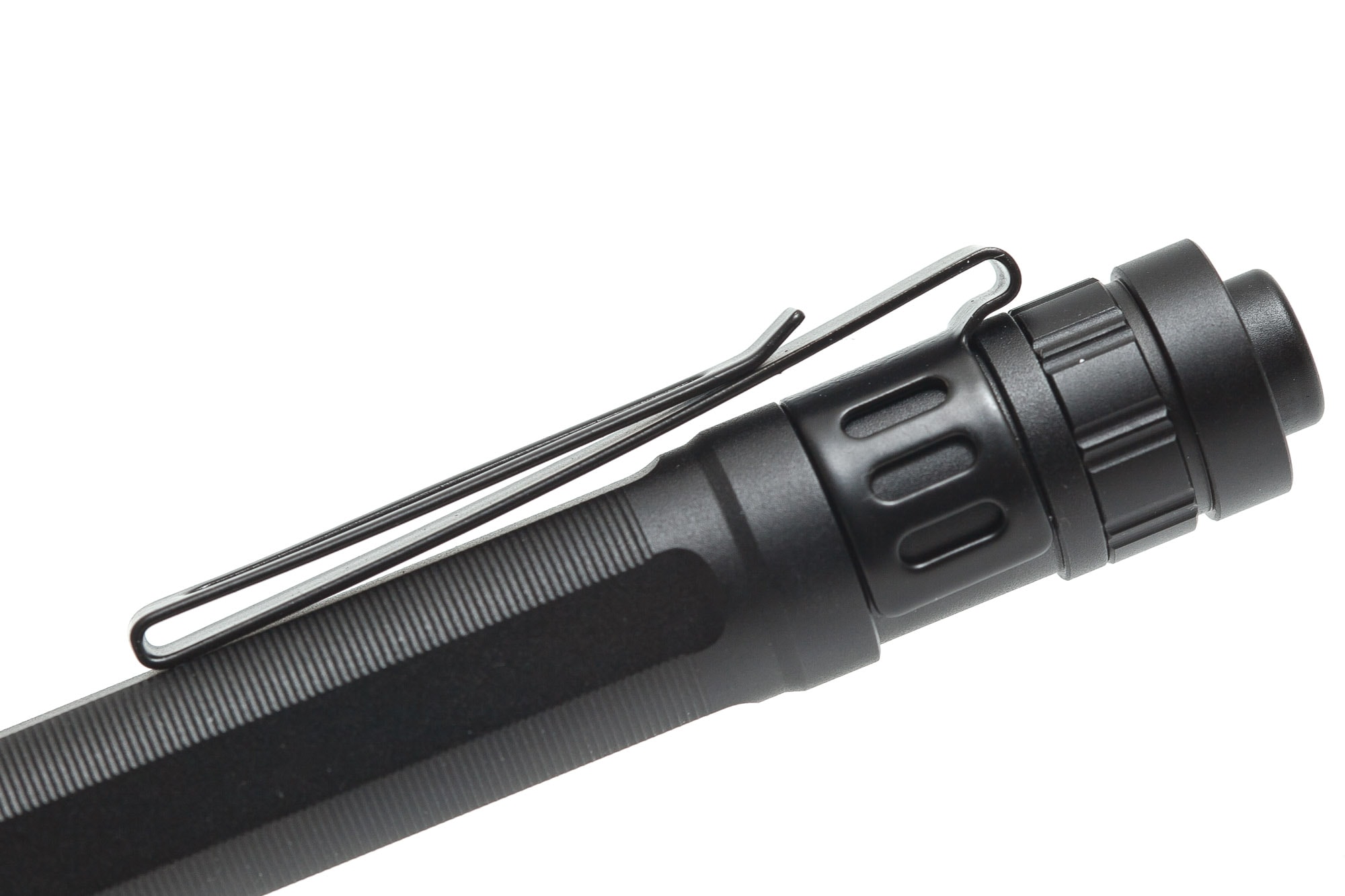
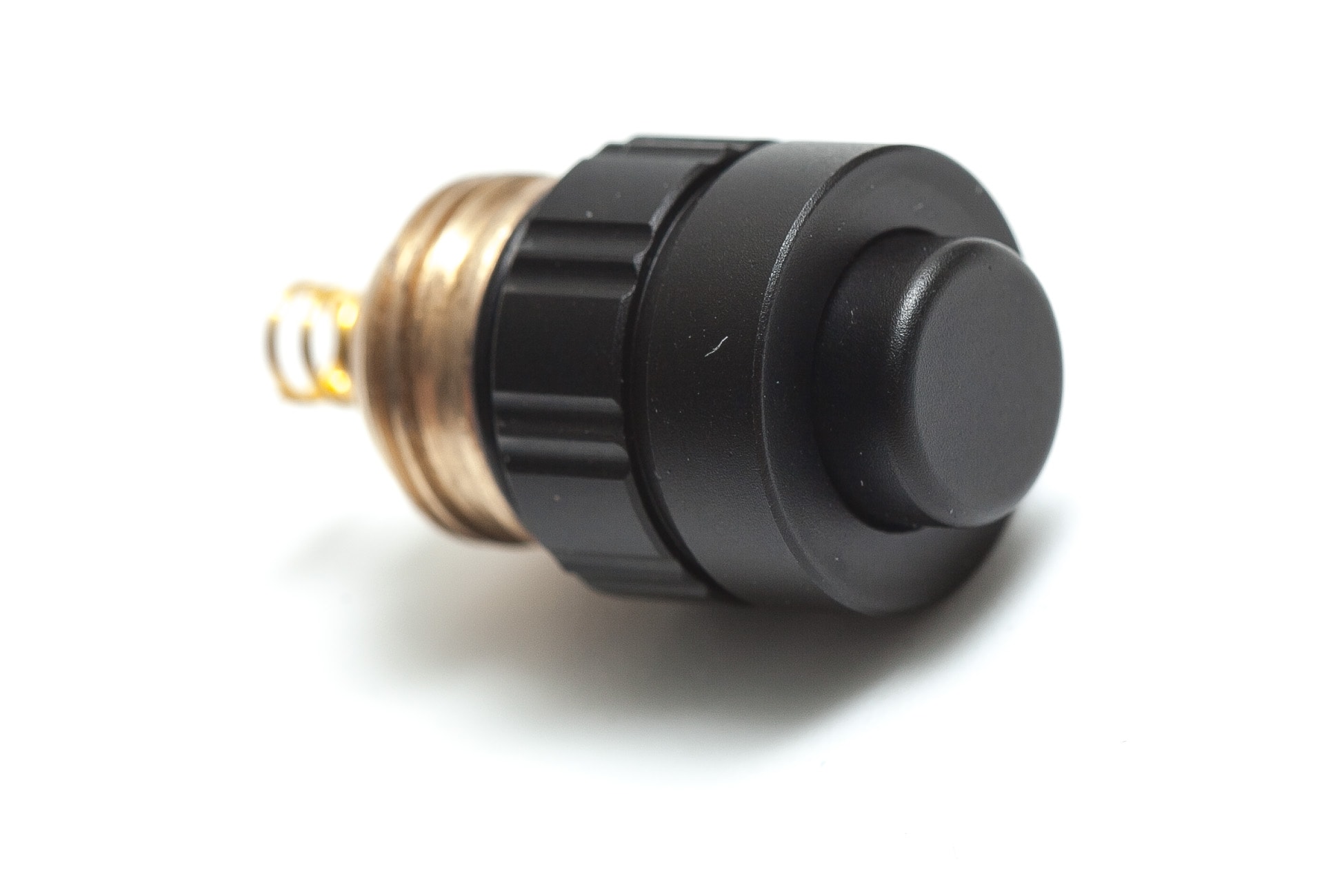
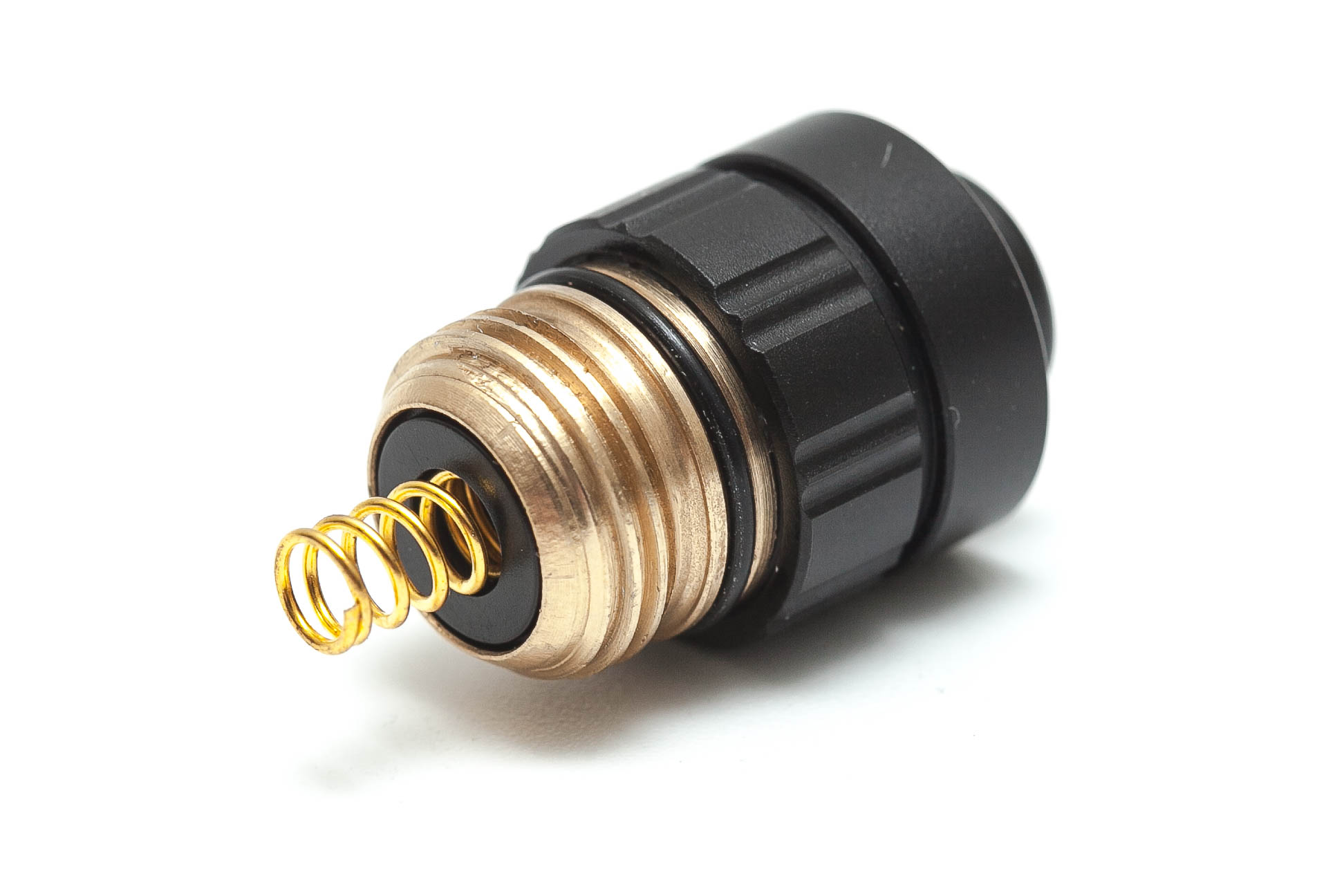
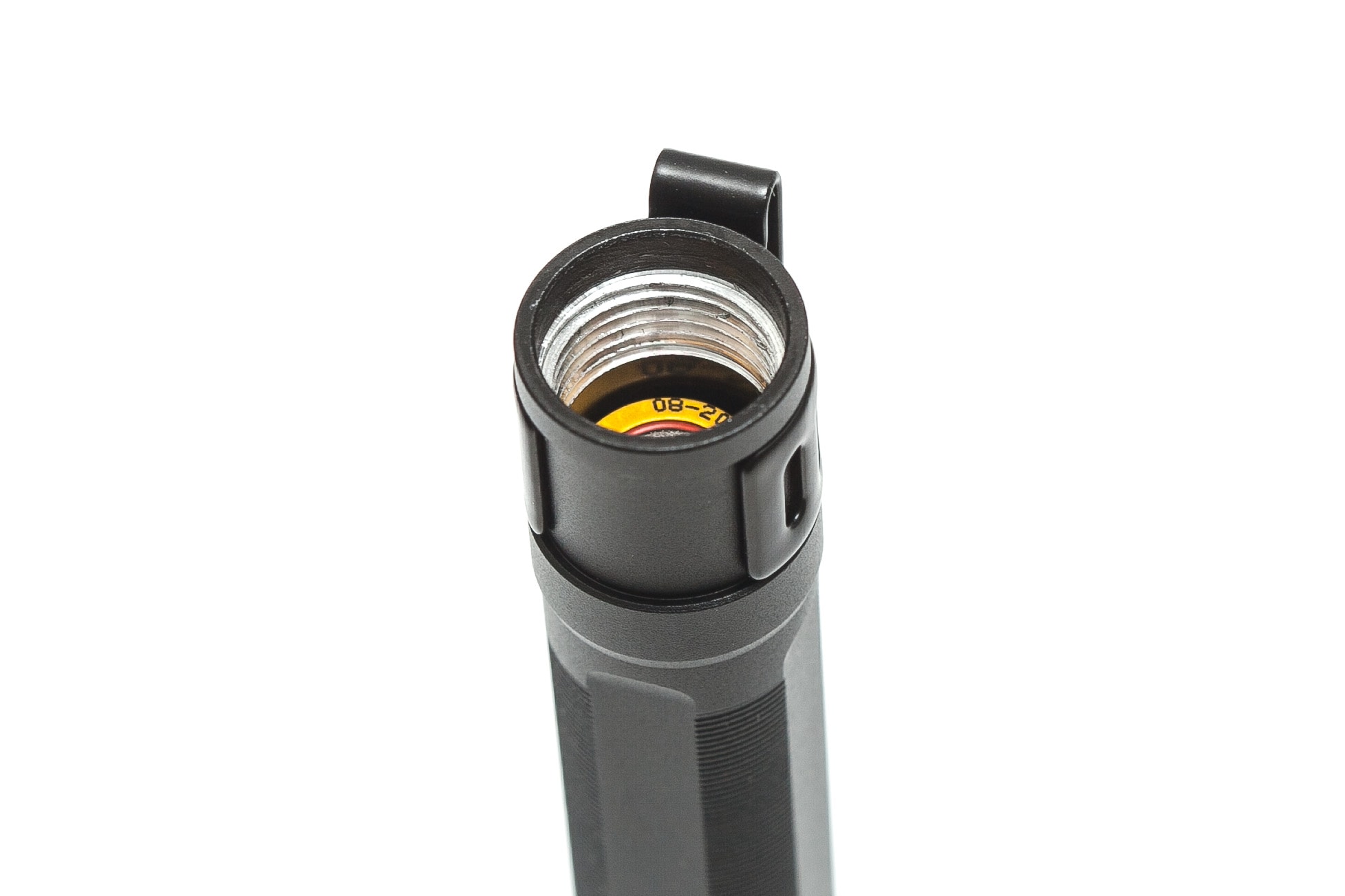
LED, Lens, Bezel, Beam, and Reflector
Speras gives the option to choose between 2 types of LEDs, namely is between an SST20 with 6500K, and an the same SST20 LED but with 4000K and high CRI (CRI>95).
Whatever LED you choose, you get a PMMA TIR optic to a very uniform beam, with a quick but smooth transition from hotspot to spill, just like the M10.
There is no bezel, as the body and head are machined from 1 piece of aluminum.
And when it comes to the beam quality, there is a clear hotspot and not too much spill.
I measured the beams in High mode with the popular Opple Light Master Pro (III), as well as the Asensetek Lighting Passport Pro Standard spectrometer.
Here’s the measurements I got with the spectrometer:
M10 Plus with cold white
- CCT: 5793K
- CRI (Ra): 69
- CRI: 58
- Duv: 0,0138
Here’s the measurement I got for the M10 Plus with Neutral White high CRI in High mode:
- CCT: 3588K
- CRI (Ra): 95
- CRI: 94
- DUV: 0,0042
You can see the measurements I took with the Opple Light Master below. Until now, the measurements with the Spectrometer are a little lower than the Opple.
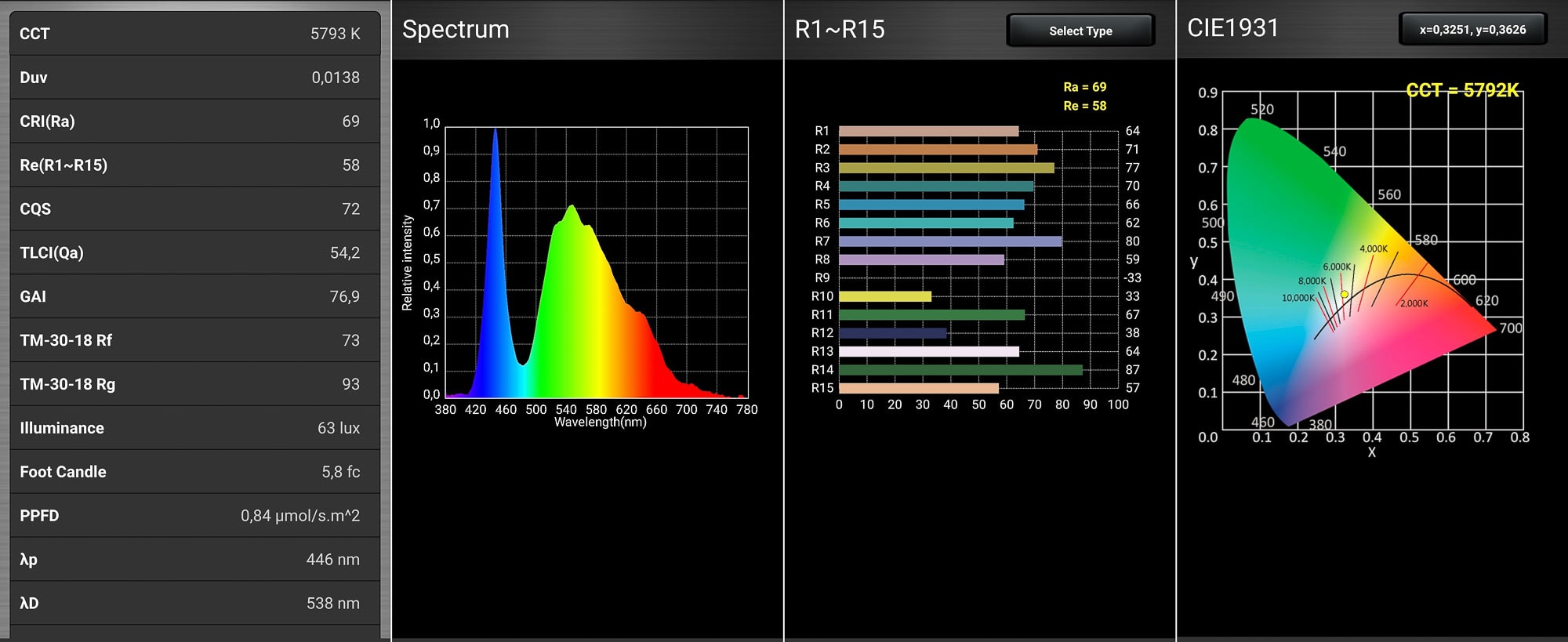
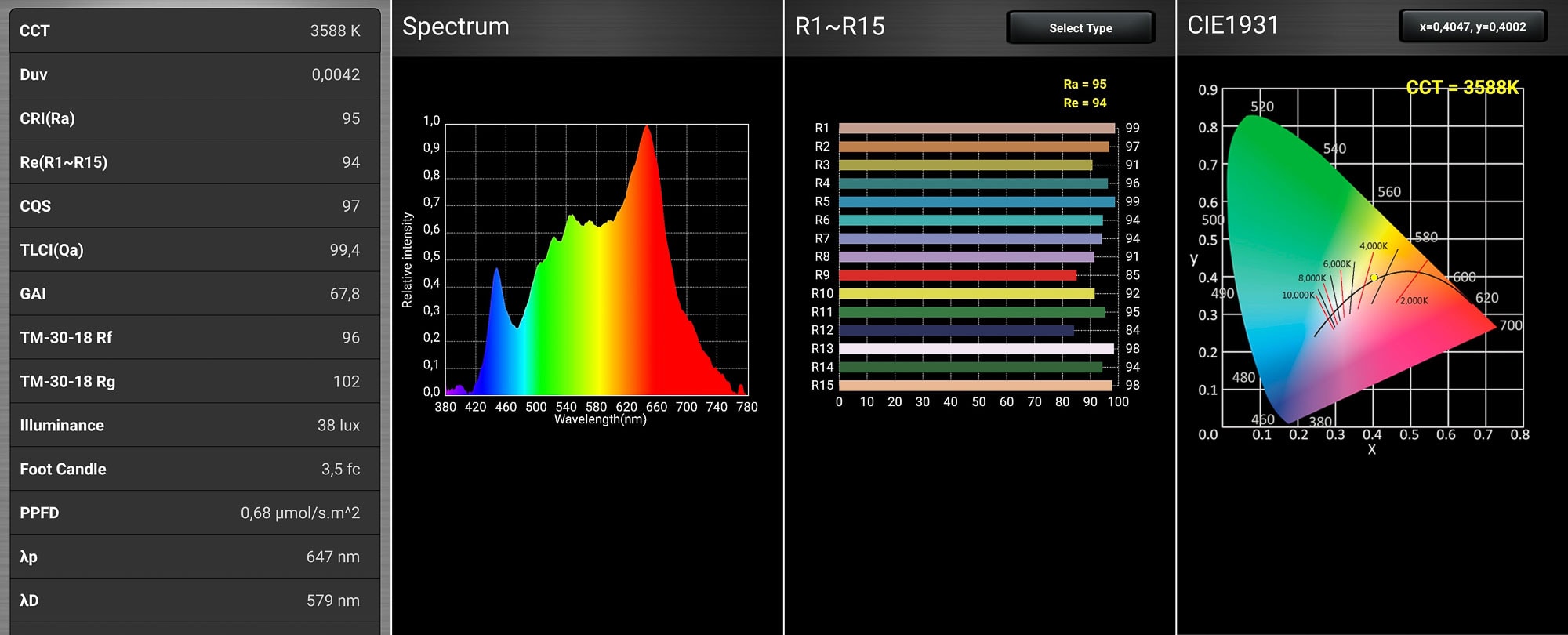
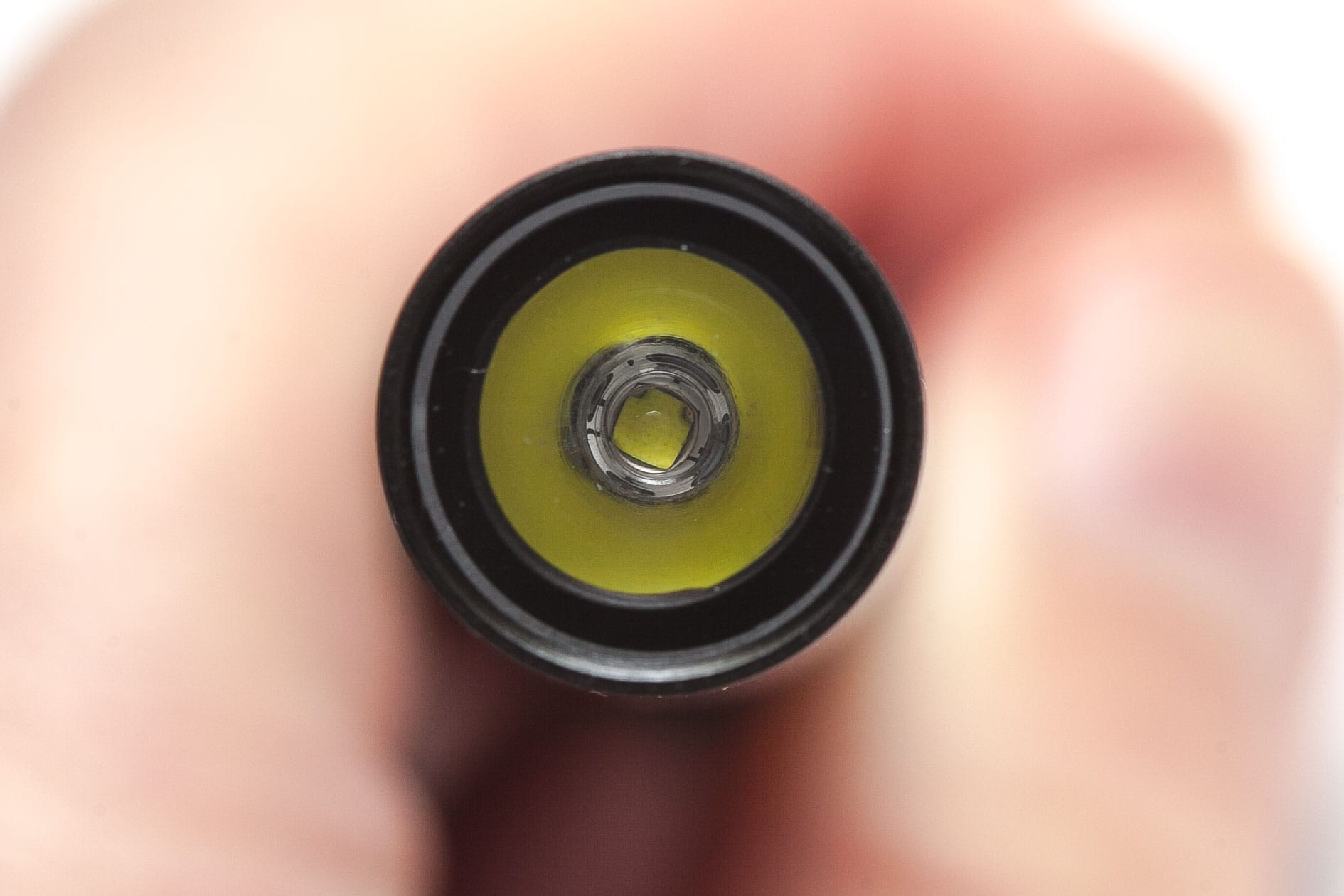
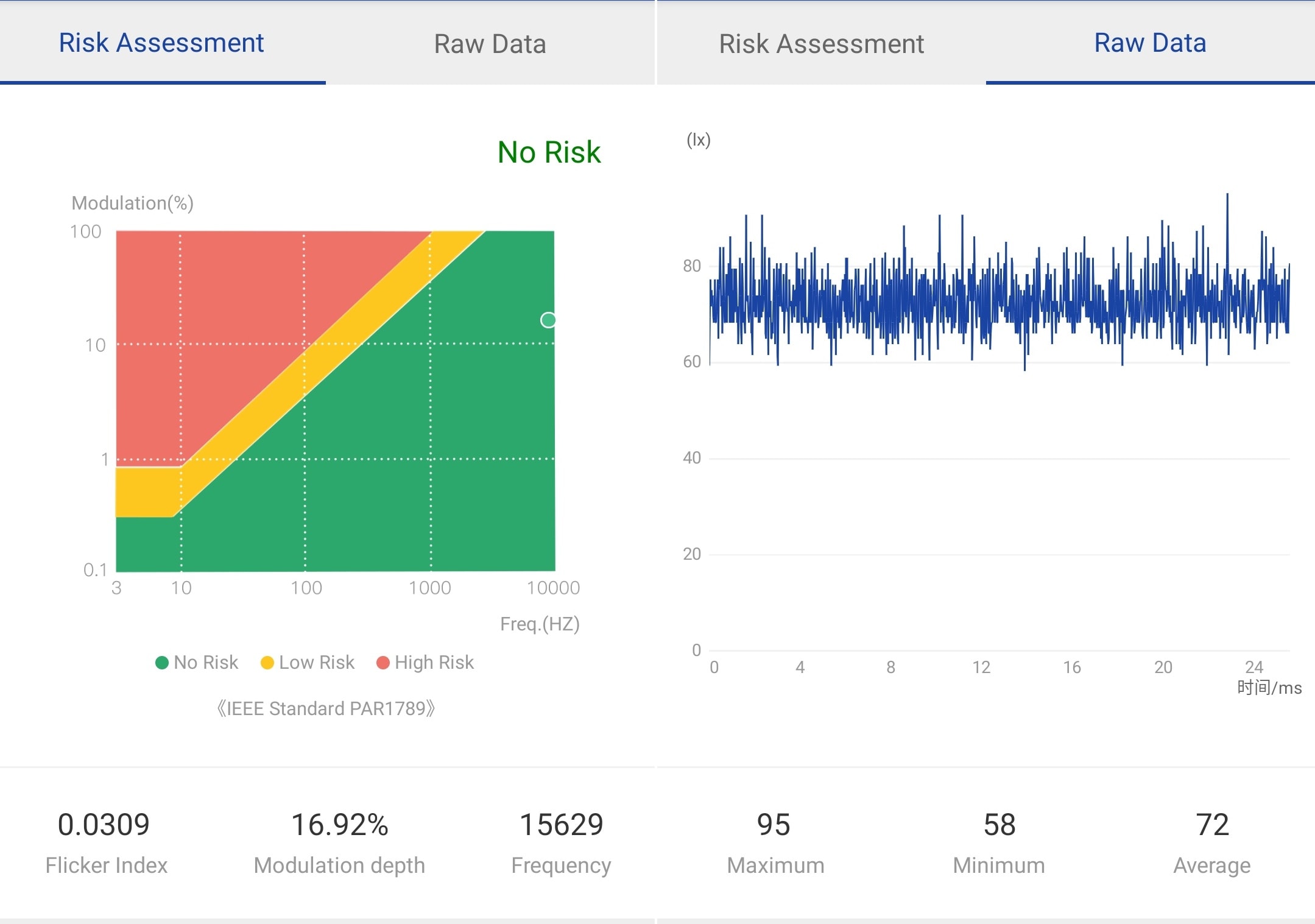
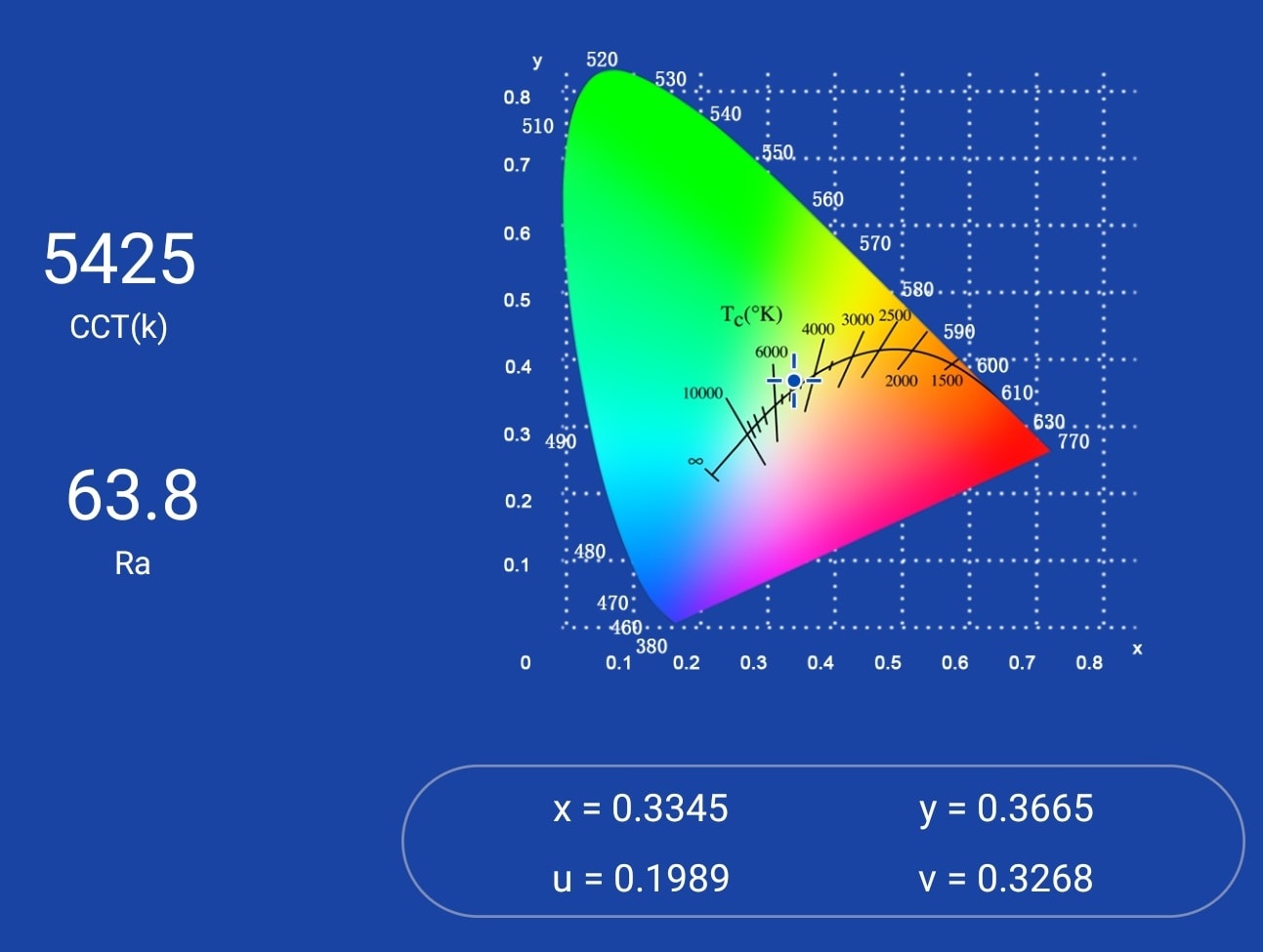
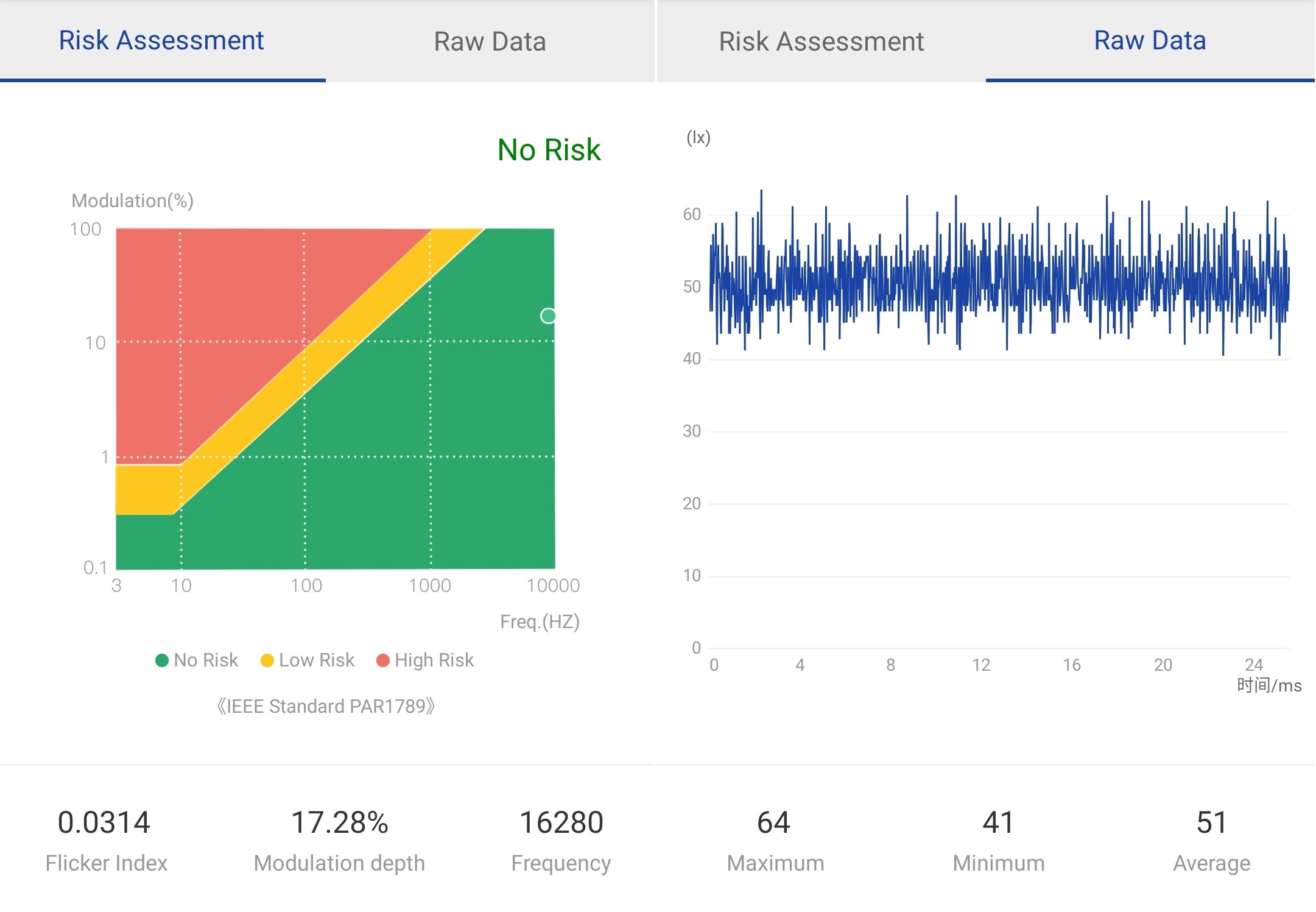
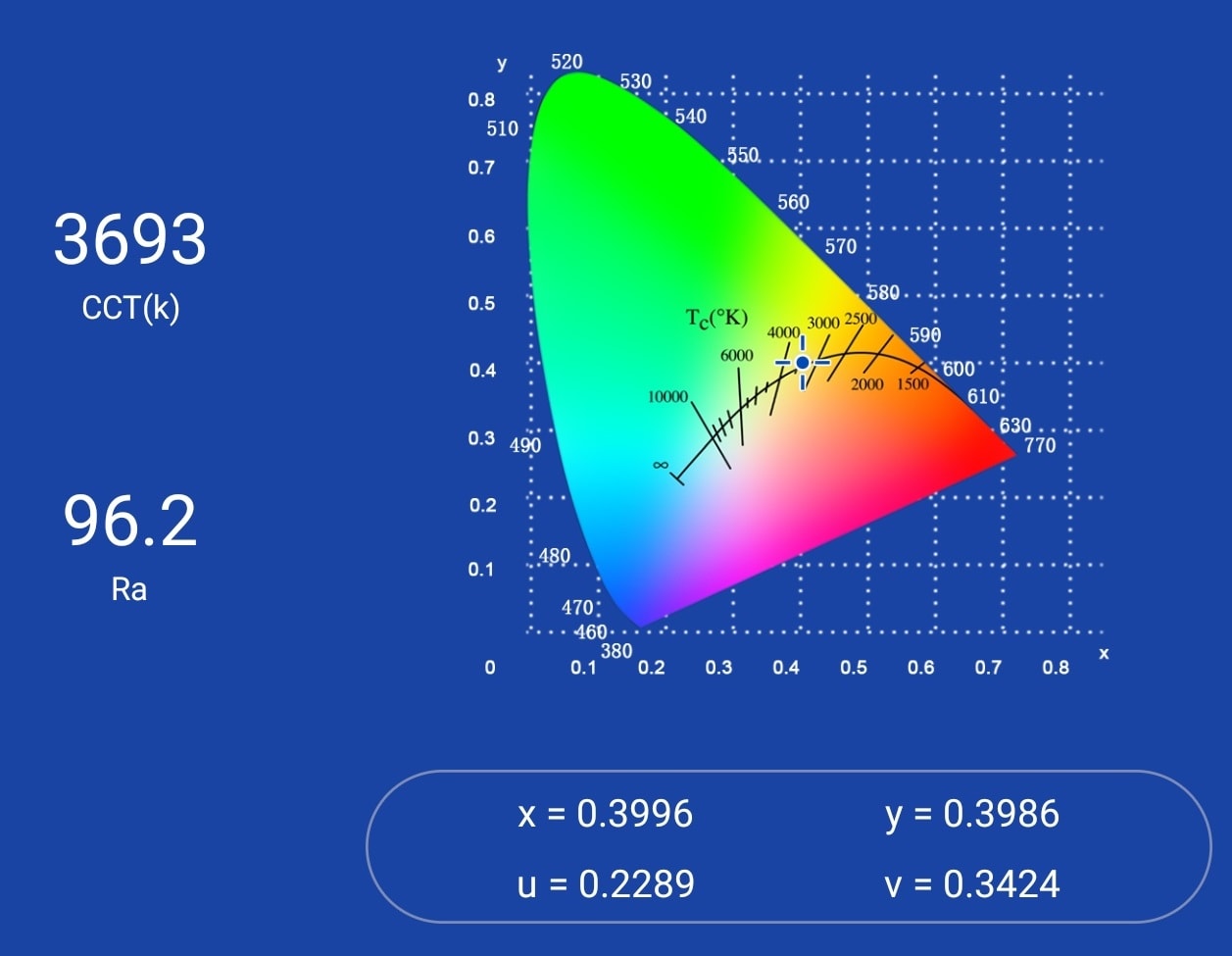
Dimensions and its competition
Dimensions:
| Speras M10 plus | Millimeters | Inches |
|---|---|---|
| Length | 131 mm | 5.2 in |
| Head diameter | 15 mm | 0.6 in |
| Body diameter | 13 mm | 0.5 in |
Dimensions are rounded to the nearest millimeter, and to the nearest tenth of an Inch.
Weight:
| Speras M10 plus | Weight in grams | Weight in oz. |
|---|---|---|
| Without battery: | 33 g | 1.16oz |
| With batteries (Alkaline) | 56.5 g | 2.0oz |
| With batteries (Eneloops) | 56.9 g | 2.0oz |
Speras M10 Plus flashlight comparison
Size compared to other AAA penlights
Group 1: from left to right: Speras M10 Plus, Speras M10 Plus, Wurkkos WK02, Weltool M6-Dr, Nitecore MT06MD, Lumintop IYP360, Olight i3T Plus, Acebeam PT10-GT, Wuben E19.
Group 2: Speras M10, and Speras M10 Plus
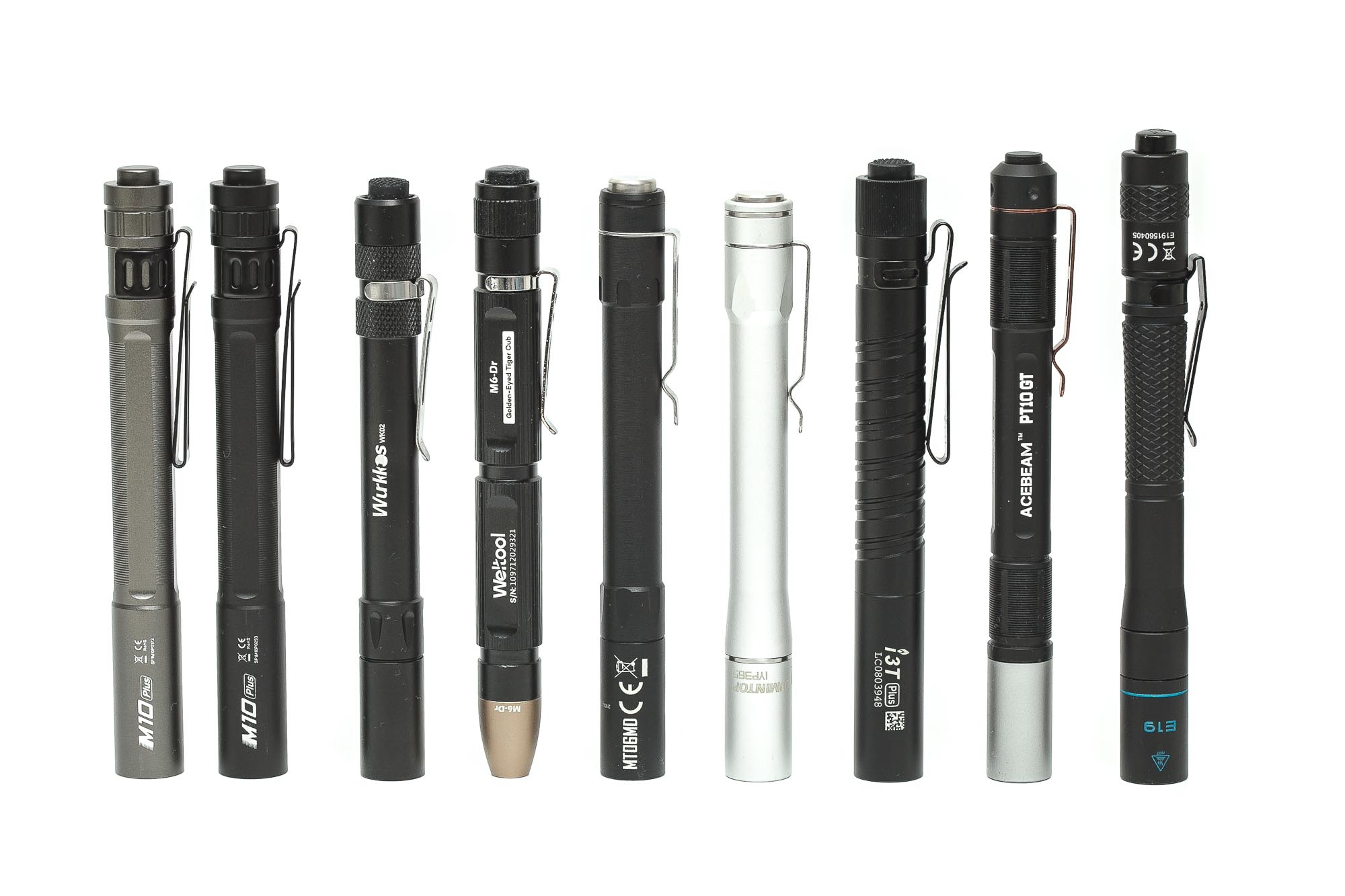
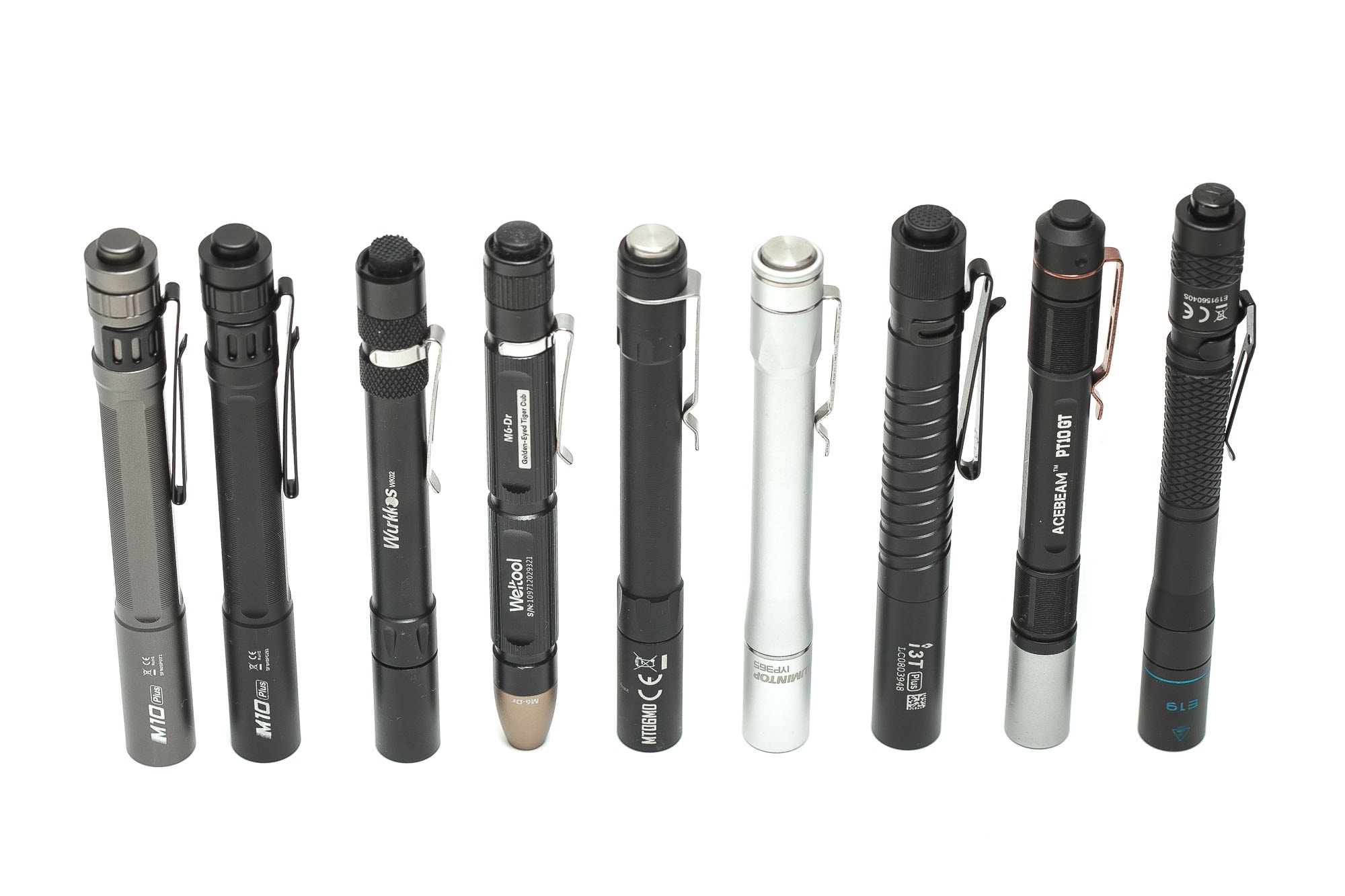
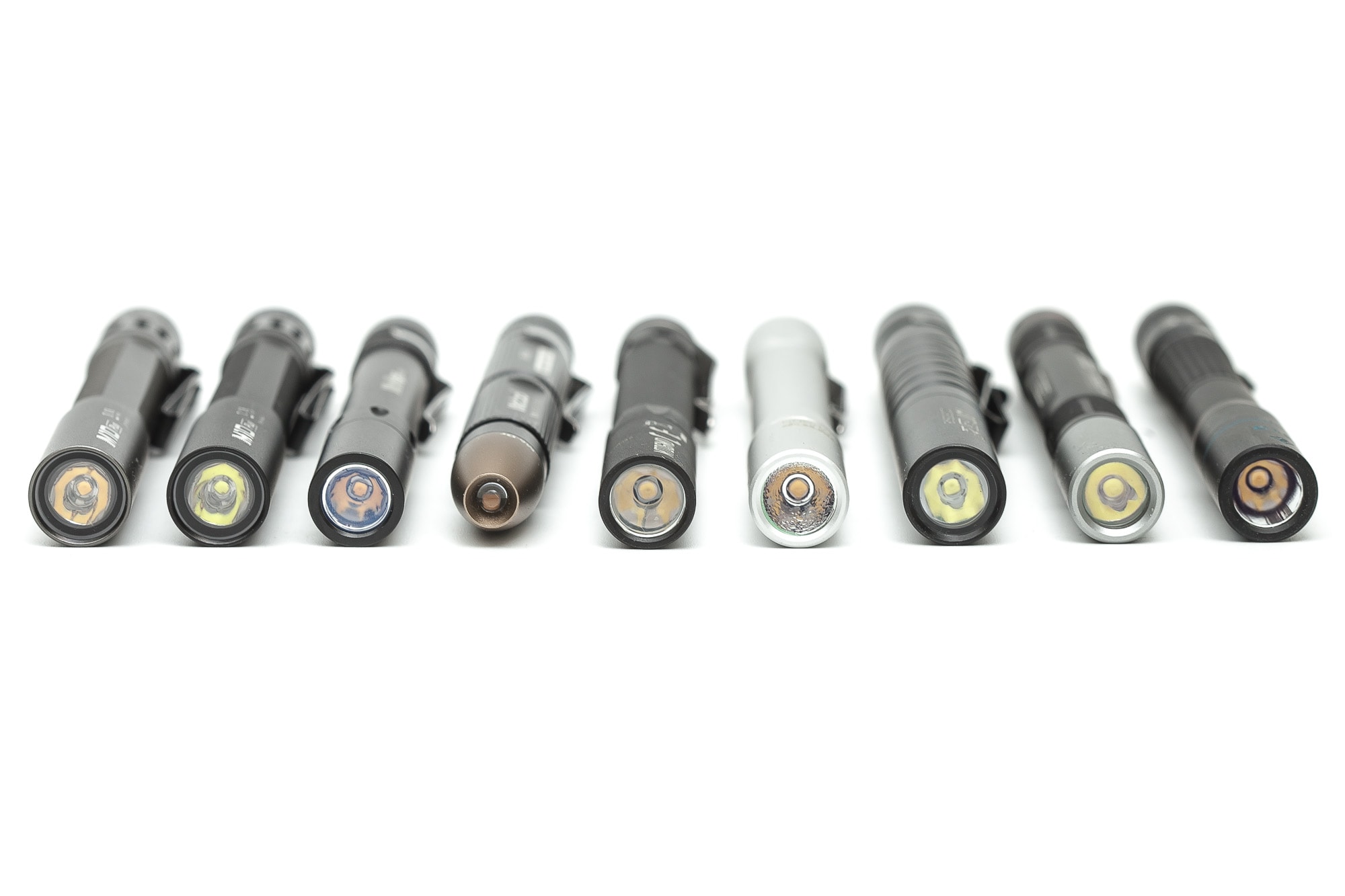
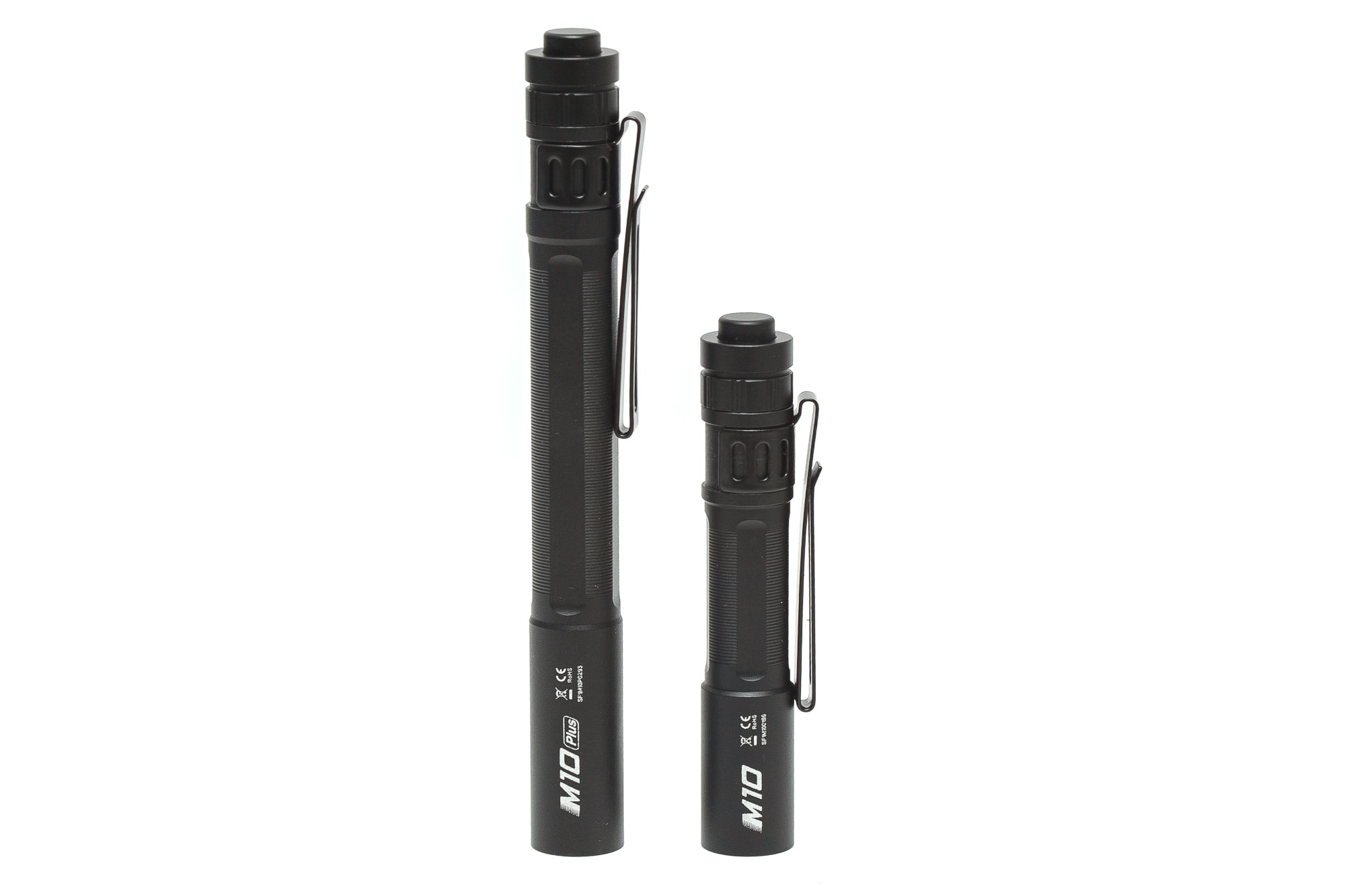
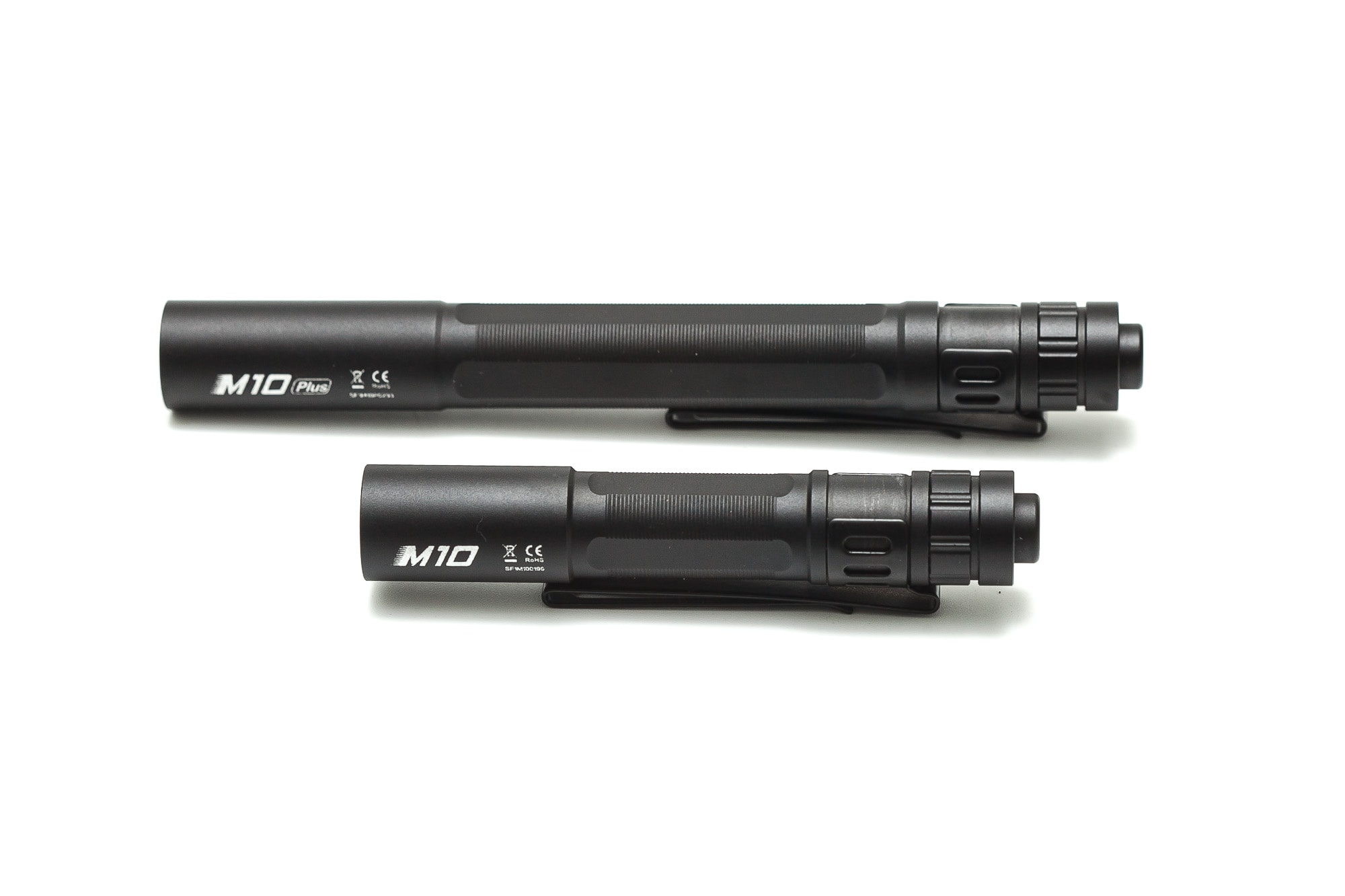
Speras M10 Plus UI: User interface and driver
The Speras M10 Plus has a reverse clicky switch, unlike its smaller brother, the M10. This means that you can select the mode, while the light is activated.
Available main modes:
- Low, Medium, and High
Available special modes (blinkies):
- None
From OFF:
- Half-press: Nothing
- Single-click: activates the light (with mode memory)
From ON:
- Half-press: changing modes from Low to High
- Single-click: turns off
Shortcuts:
- There are no shortcuts
Mode memory:
- Yes, so you will return to the last used mode
Blinky modes menu:
- There are none
Low battery warning:
- Not really, but the output will be reduced
Lock-out mode:
- No, but it has a mechanical switch, so a lockout may not be necessary.
PWM:
- Not visible by eye
Speras M10 Plus Charging and batteries
I can be brief here since there is no onboard charging.
And in terms of batteries, the M10 Plus arrived with 2 Alkaline AAA batteries, without an insulator. This means that you can use the flashlight out of the box. However, 1 of them arrived with empty batteries. It was probably activated by someone, somewhere, without them knowing?
BTW, I do not recommend leaving the Alkaline battery inside the flashlight when in storage. There are just too many occasions Alkaline batteries leaked inside a flashlight and made it useless.
We recommend using rechargeable NiMH batteries like the standard Panasonic Eneloop AAA.
Alkaline batteries are weaker but have a higher voltage. And they can also run the flashlight longer until they are completely drained.
Eneloop batteries will damage below 0.6V, and can give less energy at low voltage, and the M10 Plus does discharge them below a healthy level, unfortunately.
Performance test
This is the gear I used for testing:
| Gear | Purpose | Link to buy |
|---|---|---|
| Hagner E4-X | Measuring beam intensity (throw) | Inquire at Hagner.se |
| Extech SDL400 | Lumens and logging runtimes | Amazon.com, Amazon.co.uk, |
| Leica Disto D2 | Distance for throw measurements | Amazon.com, Amazon.co.uk, |
| Asensetek Lighting Passport Pro Standard | Spectrometer for LED measurements | – |
Lumen measurements:
The output measurements in this review are based on my homemade integrating spheres, each equipped with an Extech SDL400 Lux Meter. For consistency and accuracy, a calibration light (Convoy S2+ with 249lm and a Convoy S2+ with 261lm) is measured prior to each set of lumen measurements.
For high-output lights, one of the lux meters uses an ND camera filter to prevent the lux meter to max out. This is either the Kenko PRO1D ND16 up till about 80,000 lumens or Gobe ND32 for anything above.
All of my readings were taken from a fully-charged Panasonic Eneloop AAA battery. I used the included AAA battery for runtime testing, so I could only do 1 test.
The measurements were taken manually at turn on and 30 seconds. The 10-minute numbers are taken from the runtime graph. Keep in mind that the Alkaline measurements at 30 seconds could actually be 31 or 32 seconds, because of the delay in the Extech SDL400 luxmeter when press record. Also, 1 of the flashlights arrived with dead Alkaline batteries, so I couldn’t test it.
| Mode | Specs | Turn on | 30 sec | 10 minutes |
|---|---|---|---|---|
| CW Low (Eneloop) | 3 lm | 6 lm | 6 lm | – |
| CW Med (Eneloop) | 100 lm | 100 lm | 95 lm | 54 lm |
| CW High (Eneloop) | 250 lm | 257 lm | 245 lm | 73 lm |
| CW High (Alkaline) | 250 lm | 251 lm | 241 lm | 73 lm |
| NW Low (Eneloop) | 3 lm | 4 lm | 4 lm | – |
| NW Med (Eneloop) | 80 lm | 84 lm | 76 lm | 52 lm |
| NW High (Eneloop) | 200 lm | 181 lm | 173 lm | 75 lm |
NW measured quite a bit lower than specs, while CW was relatively close.
Speras M10 Plus battery life and runtime
The runtime test was done with the 50cm home made integrating sphere, combined with the Extech SDL400 data logging Lux Meter. I didn’t test Low mode, because it would run for 100 hours according the specs.
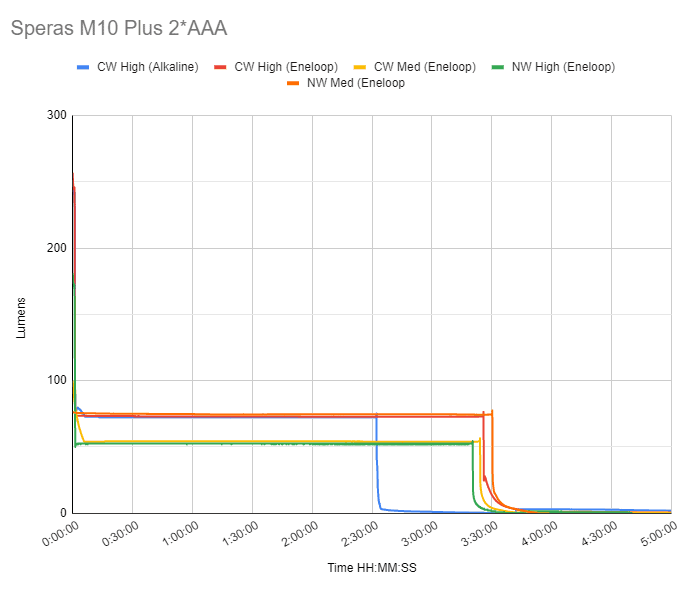
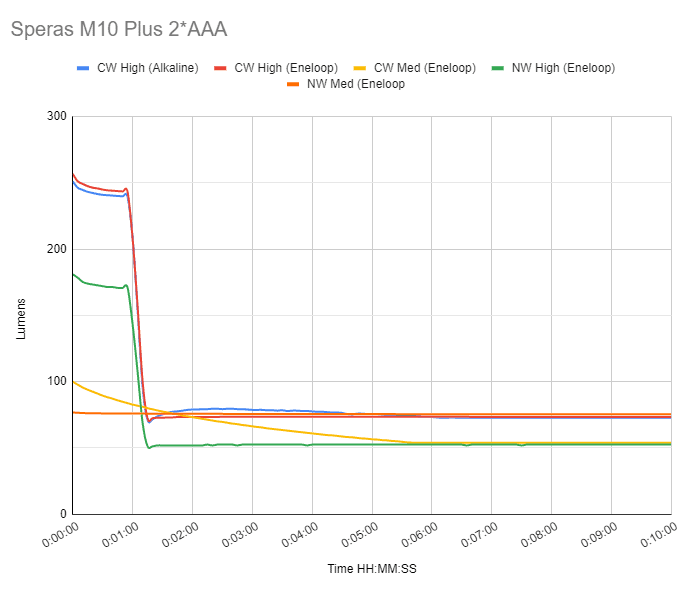
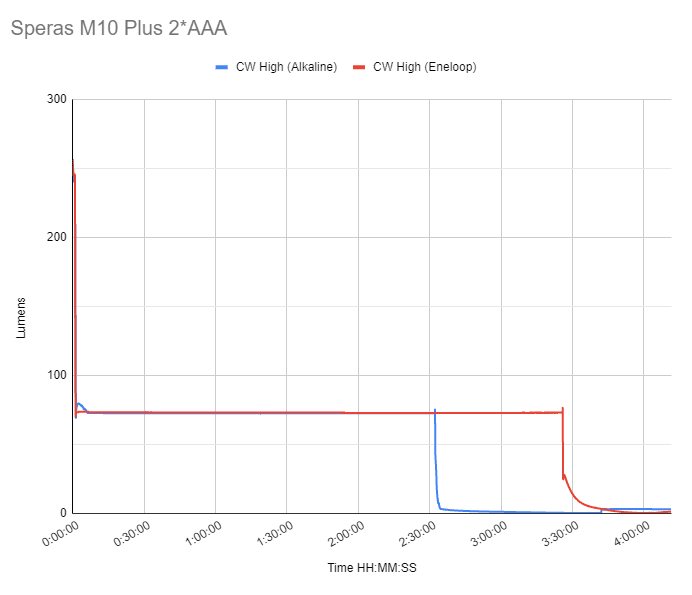
| Mode | Specified | Measured runtime (ANSI FL1) | Time till shut off |
|---|---|---|---|
| CW Med (Eneloop) | 3h 03min | 3h 26min | 3h 39min |
| CW High (Eneloop) | 1min+3min+3h | 3h 27min | 3h 53min |
| CW High (Alkaline) | 1min+3min+3h | 2h 32min | 12h 11min+ |
| NW Med (Eneloop) | 3h 03min | 3h 34min | 3h 51min+ |
| NW High (Eneloop) | 1min+3min+3h | 3h 20min | 4h 37min+ |
The problem with this is that they discharge rechargeable batteries, like the Eneloops I used, too deep. This can easily result in damaged batteries. So be careful, and replace the batteries when the light goes to 1lumen output.
I measured mine at 0.3V and 0.7V.. this is too low for rechargeable batteries!
Alkaline vs Eneloop
The last graph shows 2 runtimes with Eneloop vs Alkaline batteries. In series, Alkaline could pretty much keep up with the Panasonic Eneloops, but had a much shorter runtime, with almost 1 hour difference.
About ANSI FL1 standards: The runtime is measured until the light drops to 10% of its initial output (30 seconds after turning on). This does not mean that the flashlight is not usable anymore. The last column shows how long the light actually works till it shuts off. If there is a + symbol, it means that the test was stopped at that particular point, but the light was actually still running. This happens on certain occasions, with certain drivers, firmware, or batteries.
Speras M10 Plus vs other penlights
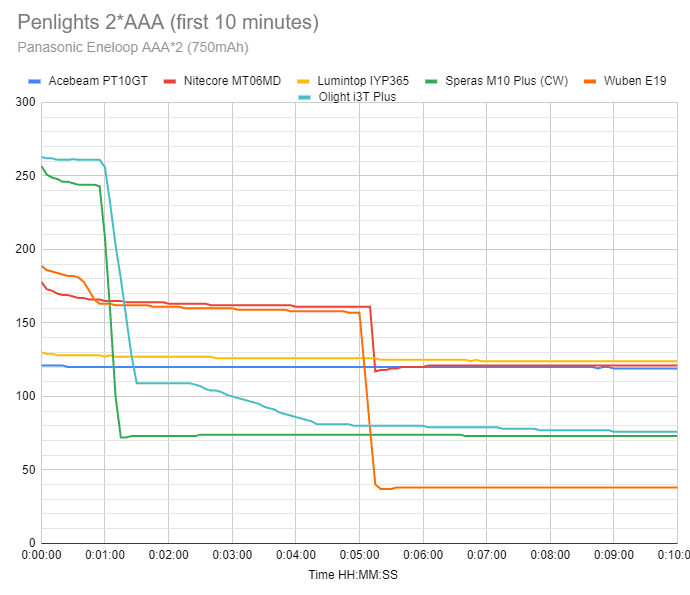
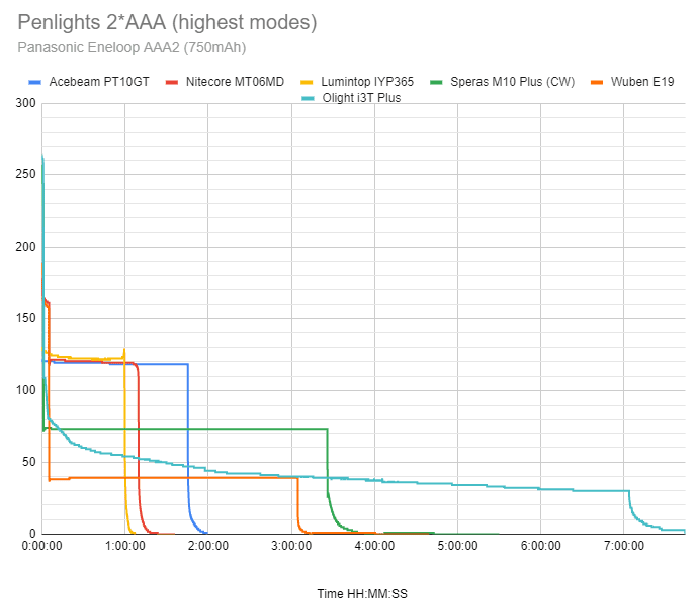
Speras M10 Plus peak beam intensity and beam distance measurements
Measurements were taken indoors with a Hagner E4-X Lux Meter, at 2 meters, only with the Eneloop AAA batteries, because the included Alkaline battery was used for testing its runtime. And looking at the data, the Alkaline would throw the beam about as far as the Eneloop.
| Mode | Specs | Candelas measured | Meters | Yards |
|---|---|---|---|---|
| Low | 12 cd | 8 | 6 | 6 |
| High | 840 cd | 872 cd | 59 | 65 |
| Low | 12 cd | 8 | 6 | 6 |
| High | 456 cd | 688 cd | 52 | 57 |
Fortunately, they easily reached the claimed candelas.
About peak beam intensity: Peak beam distance according to ANSI FL1 standards: The calculated value of distance in meters at which the flashlight produces a light intensity of 0.25 lux. (0.25 lux is about the brightness of a full moon shining on an object). The columns ‘Meters’ and ‘Yards’ use rounded numbers.
Beamshots
For the following beamshots, I used a Canon EOS 5D Mk2 with a 50mm lens. Manual settings: ISO1600, 1/30sec, F4, 5000K
The white wall is about 5 meters away, and the fence is about 4 meters.
Compared to the following flashlights:
- Speras M10 Plus
- Wuben E19
- Olight i3T Plus
- Acebeam PT10GT (with Eneloops)
- Lumintop IYP365
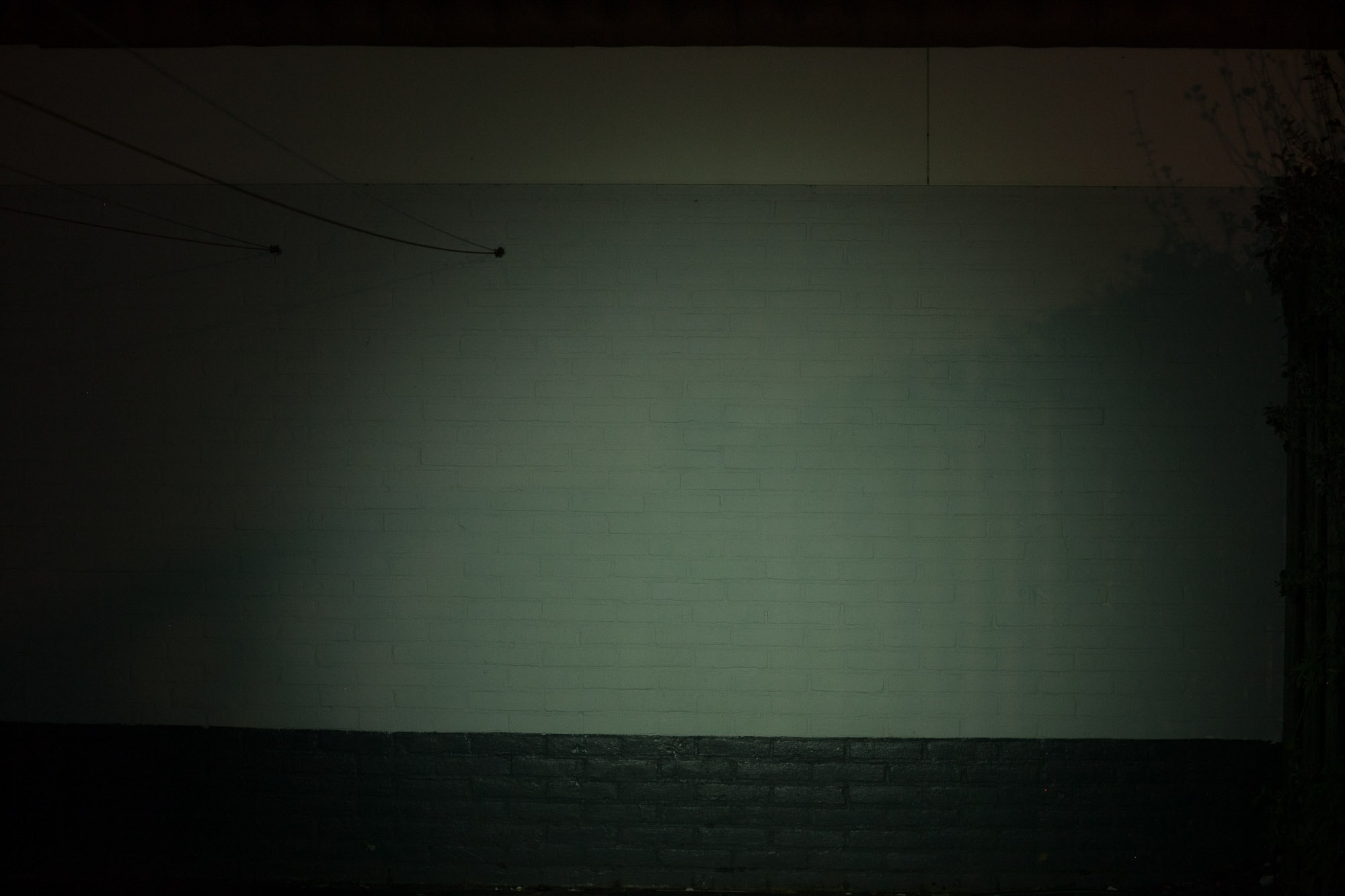
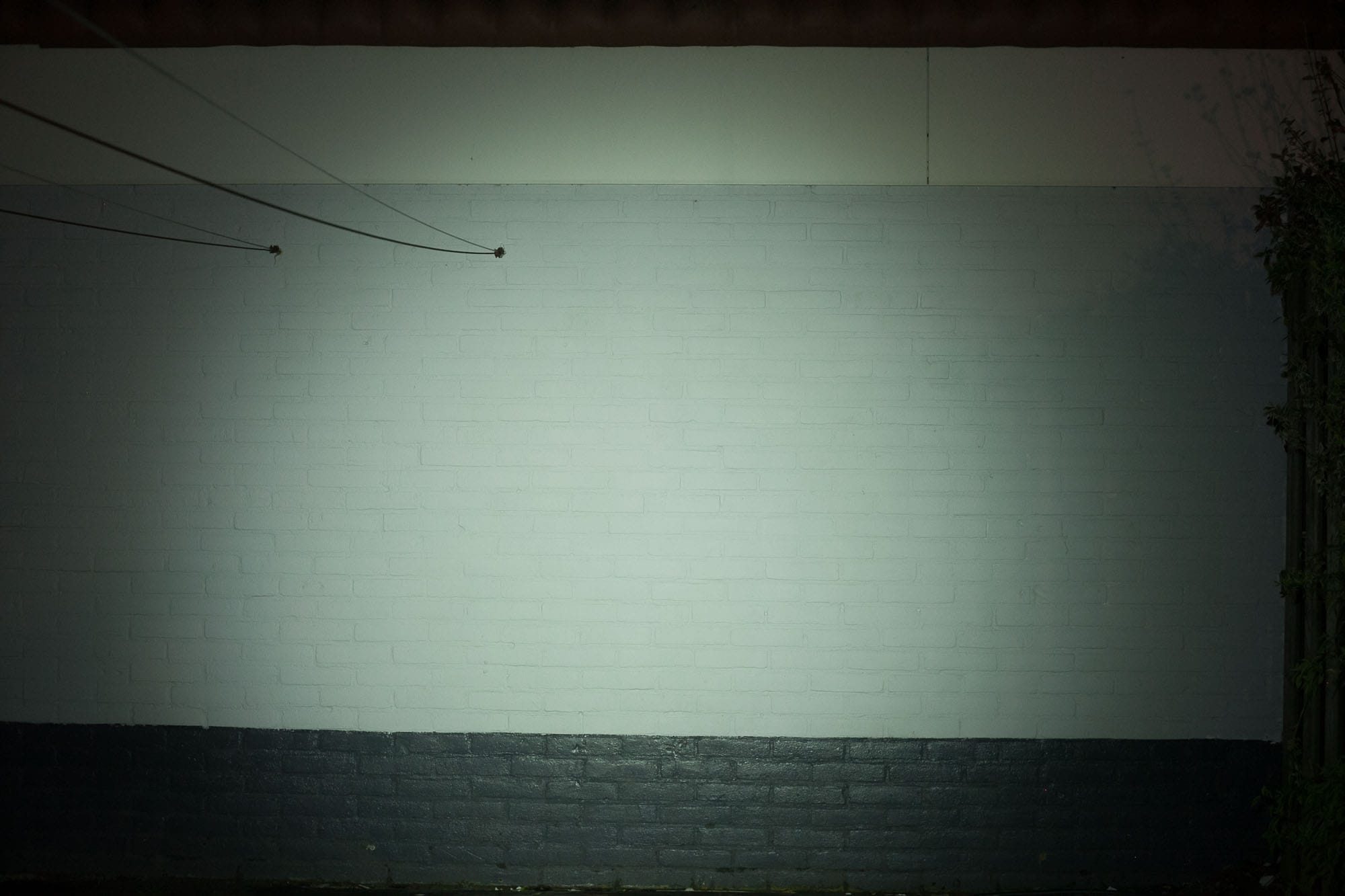





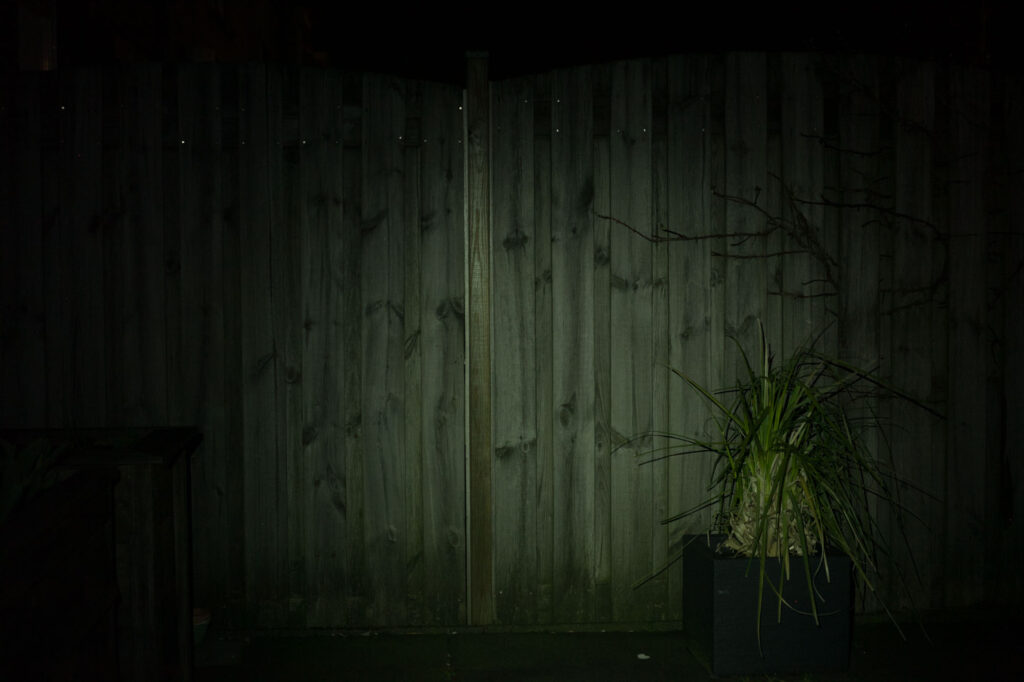
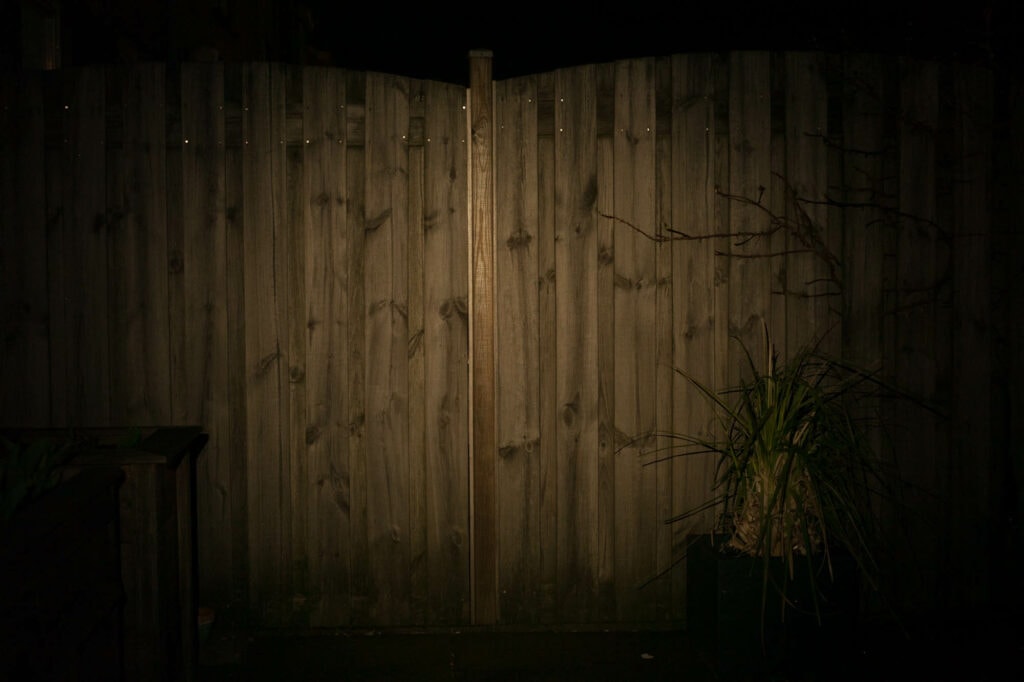
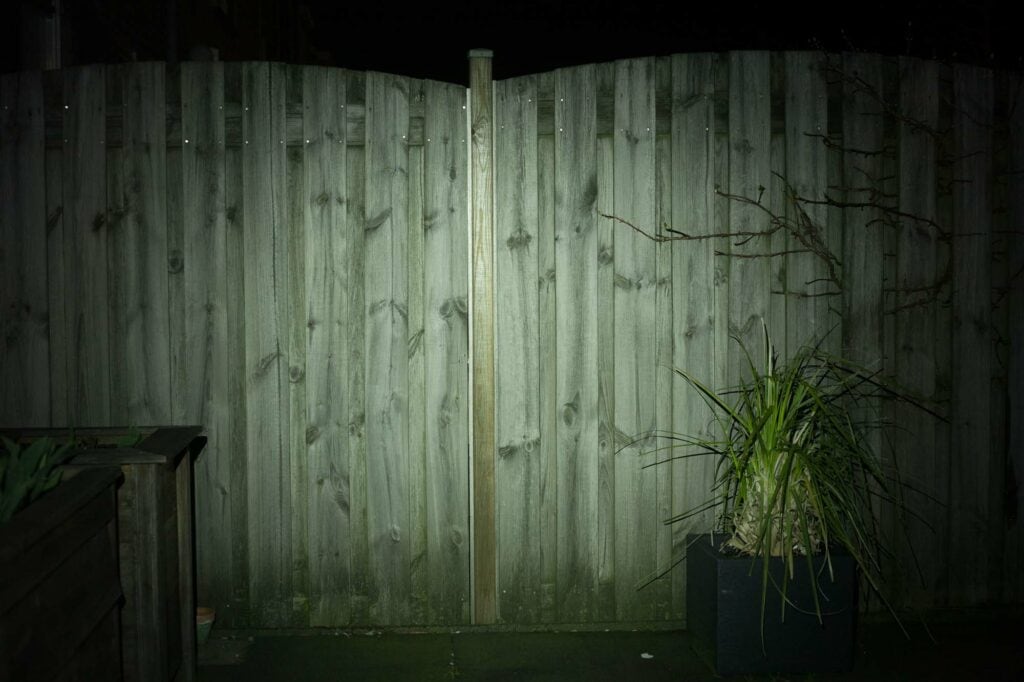



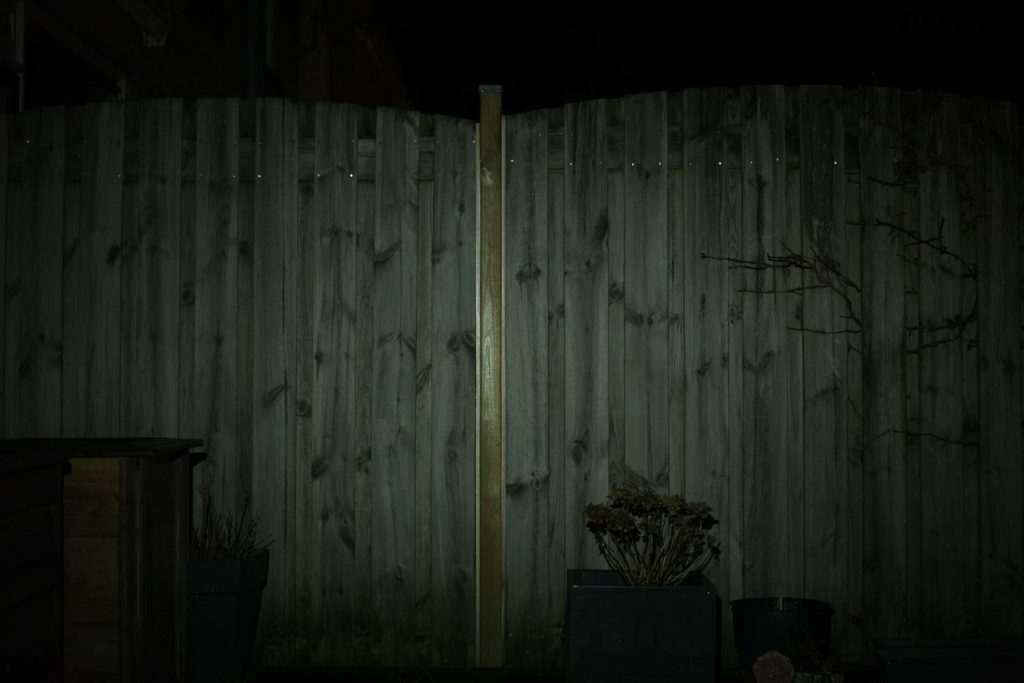

Disclaimer: This flashlight was sent to me for review at no cost by Speras. I have not been paid to review, nor have I been holding back on problems or defects.
Final Verdict
Pros
- LED choice between CW and High CRI NW
- Includes a 2-way pocket clip
- No PWM visible
Cons
- High drops to low-mode a bit early, even if Voltage is still adequately high.
- 1 of the 2 flashlights arrived with dead batteries
- Flashlight discharge NiMH batteries too deep, like most other penlight flashlights
- The battery is shipped inside the flashlight without an insulating disc
- Not reaching near the claimed output for the NW version
Explanation on star ratings:
1: Avoid: my phone flashlight would be a better choice – 2: Poor: significant defect or issues; almost unusable – 3: Average: some defects or issues; but still usable 4: Good: recommended (minor issues) – 5: Great: highly recommended

4.5 stars: ★★★★⋆
The Speras M10 Plus puts out quite a bit of lumens when compared to the other penlights tested. But the output drops relatively quickly, and to a low output. I’m mostly talking about the CW version then.
The NW high CRI version’s output is quite a bit lower, and doesn’t reach close to the advertised output.
Buy your Speras M10 Plus here
1lumen selects and reviews products personally. We may earn affiliate commissions through our links, which help support our testing.